 |
The Hissem-Montague Family  |
 |
The Hissem-Montague Family  |

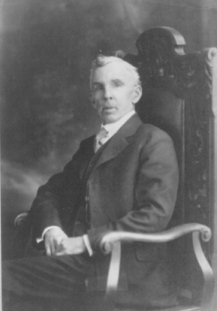 (24) Leroy Couch Montague (1853)
(24) Leroy Couch Montague (1853)Anita's Great-Grandfather. From "History and Genealogy of the Montague Family of America" - The youngest son of David Owen Montague, he was born on 5 January 1853 in La Motte, Jackson county, Iowa, a farming community near the Mississippi river. He was first listed in the 1860 census while living with his parents in Richland, Jackson county, Iowa. He was 7 years old at that time.
The family moved south, but stayed on the river. In the 1870 census of Lyons City, Clinton county, Iowa as Leroy C. Montague, a 17 year old farm laborer, born in Iowa. He was living at home with his parents and sister, Polly. Clinton county is just south of Jackson county and Lyons City is a small town, now called simply Lyons, on the Mississippi river. A panoramic engraving of the city of Lyons, circa 1868, is below.

Leroy C. Montague married Arvilla M. Hess on 27 February 1878 in Clinton [Lyons], Iowa. Arvilla was born in 1855, the daughter of David Hess and Ellen [Eleanor] Finch, of Clinton, Iowa. In one birth record Leroy was named Leroy Clofford Montegue and Arvilla was named Arvilla Helen Hess.
| The Hess Family |
Leroy and Arvilla had a son, Arthur David, in 1879.
| Iowa Settlers
The first 'official' white settlement in Iowa began in June 1833, in the Black Hawk Purchase. Most of Iowa's first white settlers came from Ohio, Pennsylvania, New York, Indiana, Kentucky, and Virginia. They discovered an environment different from that they had known back East. Most northeastern and southeastern states were heavily timbered; settlers there had material for building homes, outbuildings, and fences. Moreover, wood also provided ample fuel. Once past the extreme eastern portion of Iowa, settlers quickly discovered that the state was primarily a prairie or tall grass region. Tress grew abundantly in the extreme eastern and southeastern portions, and along rivers and streams, but elsewhere timber was limited. In most portions of eastern and central Iowa, settlers could find sufficient timber for construction of log cabins, but substitute materials had to be found for fuel and fencing. For fuel, they turned to dried prairie hay, corn cobs, and dried animal droppings. By the 1870s, farms and small towns blanketed the entire state. In that decade Iowa farmers established definite production patterns, which led to considerable prosperity. During the Civil War, Iowa farmers had raised considerable wheat. After the war farmers diversified their production, raising corn rather than wheat, and converting that corn into pork, beef, and wool whenever possible. Farm work continued to be dictated by the seasons. Wintertime meant butchering, fence mending, ice cutting, and wood chopping. In the spring, farmers prepared and planted their fields. Summertime brought sheep shearing, haying, and threshing. In the fall, farmers picked corn, the most difficult farm task of all. |
Leroy was a farmer, the primary employment in Iowa at that time. After his marriage Leroy moved west to settle in Greene county, in the center of the state. It was here that their son, Arthur, died of "lung fever" in March 1880. - from the U.S. Federal Census Mortality Schedules. Lung fever is an archaic term for pneumonia.
In the 1880 census of Paton, Greene county, Iowa as Leroy Montague, a 27 year old farmer. Living with him was his wife, Arvilla, 25. His parents were both listed as being from New York state. This may have been confusion of Leroy's part since his parents lived in New York from at least 1829 to sometime before 1845. Arvilla's parents were listed as being both from Canada. Her older sister, Mariette Hess [Marie Hesse in familysearch.org], 29, was living with them.
An interesting point is that at the time of the 1880 census all three Montague brothers were living in different parts of the state; Zenas still in La Motte, Judson in Davenport, with his father, and Leroy in Paton. They don't seem to have been a very close family.
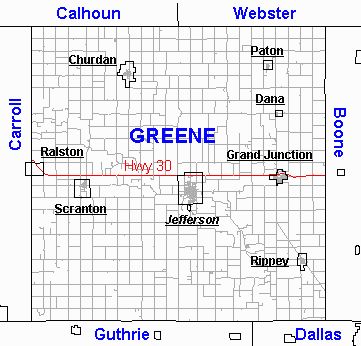

A son, Guy Judson Montague, was born on 27 July 1881 in Greene county, Iowa. A daughter, Blanche, was born on 17 August 1883, also in Greene county, but she died within the year. An unnamed son, termed a "4th child," was born on 21 September 1885, in Boone county, Iowa, and died sooon after. Boone county is immediately to the east of Greene county. Another daughter, Hazel Margaret Montague, was born in 1886, and a son, Lee Roy Montague, their last child, in 1890, also in Boone county.
In the 1885 state census of Boonesboro, Boone county, Iowa as Leroy C. Montague, a 31 year old farmer, of Jackson county. Living with him were his wife, Arvilla, 30, of Clinton county, and son, Guy, 3, of Greene county.
"Montague, L.C. [age] 37 U.S. Farmer [post office] Paton [township] Paton" was listed in the 1890 Assessor's List for Paton township, Greene county.
For reasons I don't yet understand, Leroy once again moved his family and this time went west to settle in Inyo County, California, moving there sometime after 1890. Arvilla's sister, Marietta Hess, who was living with the family in 1880, married Nelson L. Satterlee on 30 September 1889 in Boone, Iowa, but then died on 6 February 1890. Could that have influenced their move? Note also that Leroy's older sister, Harriet Newell Montague, had married Caleb Burlison McDowell and moved to the area near San Bernardino, California in about 1882. Perhaps she wrote and told Leroy how good things were in California.
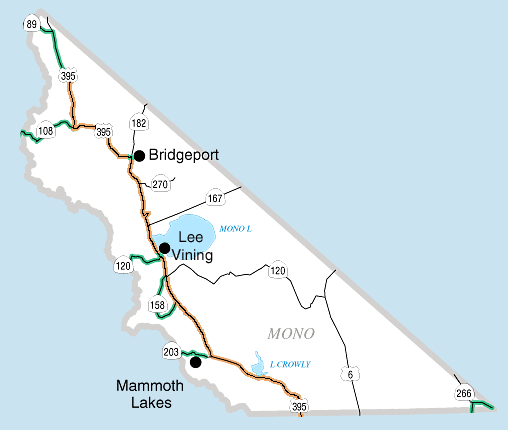 Mono and Inyo Counties Mono and Inyo Counties
These two counties are in the high desert and form a valley, running southeast to northwest, between the High Sierra's, to the west, and the Inyo mountains, to the east. Its a land of scrub and long vista's. The counties form the long eastern border with Nevada. Mono county, to the north, was formed in 1861 and is the site of the akaline Mono lake and the Mammoth mountain ski resort. Its county seat is Bridgeport. The principal industries in both counties were the mining of gold, silver and borax, ranching and farming, particularly the raising of vegetables and fruit orchards to supply the mines and local settlements.
|
I suspect Leroy moved to Inyo county in part lured by the promise of gold, but was disappointed. While gold was originally discovered in California in 1849, new strikes in the Sierra's continued through 1903. The Rand Mining District's fabulous gold strike at the Yellow Aster, just south of Inyo county in the Kern region, brought over three thousand people to the area by 1896, and many more followed. From 1908 to about 1913 the construction of the Los Angeles aqueduct also provided a magnet for young men looking for work.
According to my father-in-law, Leroy brought his family to a ranch at Black Rock, California, an area between the towns of Independence and Big Pine in the Owens river valley. Black Rock refers to the great quantity of lava rock in the area. Below is a view of the Owens river as it makes its way through the valley, south of Bishop. A number of small ranches were supported along its length. By the way, there was gold and silver mining in the hills just north of Black Rock, but this area earned the name Poverty Hills.
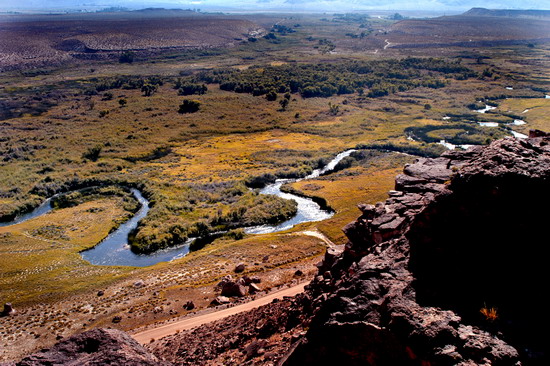
At Black Rock Leroy's wife, Arvilla Hess, died while the children were all still quite young, certainly not later than 1892. Arvilla was buried in Independence. Anita and I visited the graveyard there in 2008 and, while the burial register lists a "Montague," the spot where the register indicates she was buried has no tombstone, and, more importantly, does not have enough room for a casket.
| Black Rock
The town briefly flourished, but soon dwindled due to isolation and constant Indian troubles until Fort Independence was established. By then, many began to settle into the settlements springing up in the more fertile and pleasant western side of the Owens Valley. Mining continued, though as a town, Black Rock died. In the first decade of the 1900s, a prospecting and mining craze swept the entire region, an outgrowth of the Tonopah / Goldfield / Death Valley boom period, and interest again was focused on the old mining district. After 1910, the area became again quiet, through leasers continued to methodically take out ore throughout the 20th century. Today it is known for a government fish hatchery. It was called black rock because of the masses of black lava from cinder cones which cover the area stretching north to the Poverty Hills. These hills produced gold, lead, silver and zinc. |
After Arvilla's death the family was summarily split up. Hazel was sent to an orphaniage in Los Angeles. Guy got a job as a farm laborer. The next time I find Lee he was boarded out with the Waller family, but that was in 1900. Immediately after Arvilla's death he must have had some kind of surrogate mother, perhaps Mrs. Waller. Leroy stayed in the area for a time, working at trades and lived the life of a single man.
According to my father-in-law, Leroy then went to Los Angeles where he ran a tobacco store. In the Voter Registrations of 1892 for Los Angeles county as Leroy C. Montague, a 40 year old rancher, of Iowa. He was 5' 8'' tall, of dark complexion, light blue eyes, and dark hair. He lived in Vineland, a town on the San Gabriel river, now known as Baldwin Park. This is about 25 miles due west of San Bernardino where we find Leroy buying land this same year.
An old newspaper had a notice that showed Leroy buying land from Harriet N. M. McDowell early in 1892. She was Leroy's sister, Harriet Newell Montague McDowell. She had married Caleb McDowell back in Iowa and moved to Los Angeles county sometime after 1880.
"Real Estate Transfers.This land description refers to half of a quarter of a quarter of section 7, of a township 1 South and 2 West from the San Bernardino meridian & baseline. A section is 640 acres, so this description equates to 20 acres. I believe this plot is north of the Santa Ana river, near Mentone, in San Bernardino county.
Tuesday, Jan. 26, 1892.
. . .
Harriet N M McDowell to Leroy C Montague - W 1/2 of NW 1/4 of NE 1/4 sec 7, T 1 S, R 2 W, S B M; $2000." - from the "Los Angeles Herald" of 27 January 1892
Le Roy Clifford Montague, 42 [1854], born in Iowa, registered to vote in Aberdeen, Inyo county, California on 1 June 1896. Note that at one other time Leroy's middle name was rendered as Clofford.
In the 1900 census Leroy had moved to Belleville township, in San Bernardino county, California. This was just north of Big Bear Lake. In the census of that town he was known as L.C. Montague, a 47 year old [January 1853] single rancher born in Iowa, whose parents were born in New York. This was not so far away that he could not have been in communication with his children. L.C. was sharing a residence with Albert Sainz, a 34 year old mill man, of Nevada.
| Belleville Ghost Town
Belleville is located in the Holcomb valley, about 8 miles North of Big Bear Lake City in the San Bernardino Mountains of Southern California. This area is now a National Forest. Parts from the movie "Paint Your Wagons" were film at this location. This was a gold rush town which was already fading by the 1880's. |
Leroy then moved back to Inyo county. In the 1910 census of Fifth township, Inyo county, California as Leroy C. Montague, a 57 year old single man [1852], born in Iowa, whose parents were born in New York. He was a carpenter working on his own account and he had been out of work for 12 weeks during that year. He was listed as Head of the Household, though no others were listed with him. I think this meant he had his own home, which he rented. Most of the residents in this area were boarders, indicating the rough-and-ready aspect of the neighborhood in those days.
In the 1920 census of Cameron, Visalia township, Tulare county, California as Leroy C. Montague, a 66 year old general farm laborer, a widower, of Iowa. His parents were of New York.
In the 1930 census of the Los Angeles County Farm in Downey, California as Leroy Montague, 77, a widower, of Iowa. This was the poor farm.
| The Los Angeles County Farm
|
Leroy Couch Montague, b. Jan. 5, 1853, d. 1935" was buried in the Evergreen cemetery in Los Angeles. The Evergreen cemetery is just north of Downey.
"Name: Montague Leroy C, Event Type: Death, Age: 82 years, Date of Death: 1 31 35" - from the "California Death Index"There is a marker for Leroy Couch Montague. He was listed on the same placard with Harriett N. McDowell, his sister.

Leroy's children were,
(25) Arthur David Montague (1879)
(25) Guy Judson Montague (1881)
(25) Blanche Montague (1883), there is a birth recorded for a child, the son [sic] of Leroy C. Montague and Arvilla Hess, in Jefferson, Greene county, Iowa on 17 August 1883. She died in January or February 1884.
(25) Unknown Montague (1885), the son and 4th child of Le Roy C. Montague, 32 (born in Jackson county, Iowa), and Arvilla M. Hess Montague, 31 (born in Clinton county, Iowa), born on 21 November 1885, in Boonsboro, Boone county, Iowa
(25) Hazel Margaret Montague (1886)
(25) Lee Roy Montague (1890)
He was born on 12 March 1879. Arthur Montague died of "lung fever" in March 1880 in Greene county, Iowa. - from the U.S. Federal Census Mortality Schedules. Lung fever is today referred to as pyrexia arising in a background of pulmonary inflammation. Does that help?
(25) Guy Judson Montague (1881)Guy Judson Montague, the son of Leroy Couch Montague and Arvilla M. Hess, was born on 27 July 1881 in Iowa - from the "History and Genealogy of the Montague Family of America"]. His middle name was Judson, I suppose in honor of his uncle - from "Descendants of John Owen of Windsor, Connecticut."
In the 1900 census of Township 1, Inyo county, as Guy Montague, a 19 year old farm laborer, from Iowa, and living with his boss, C. B. Rawson and his niece, Helen Gifford. Guy's birth was listed as July 1880 [sic]. He may have lied about his age to get employment and to avoid being boarded out as an orphan as was his brother. Rawson was a dairy farmer.
In the 1910 census of Bishop [township 1], Inyo county, California as a single, 26 year old telephone lineman.
Guy Judson Montague, 35, of Bay Point, Calfornia [in the San Francisco Bay area], registered for the draft on 12 September 1918. He was born on 27 July 1883. He was an Electrician with the Pacific Electric M[anufacturing] Co. of Bay Point. He was shown to be tall and of medium build, with brown eyes and black hair. He listed a Mrs. A. C. Murphy of Aurora Grande [in San Luis Obispo County], California as his closest relative. This was his sister, Hazel, who had married Alex C. Murphy. Note that he doesn't list his father as next of kin while his brother, Lee, had shown himself as his father's sole support.
The 1920 Federal census of Antelope township, Mono county, California as Guy Montague, 37 years old, and born in Iowa. He appears to be living in a boarding house, that is, there are eight men, all listed as the Head of their household, all at one location, and all laborers. I suspect this was a work gang of some sort, living in company quarters.
Guy Judson Montague married Kate Bigelow on 18 September 1918. She was born on 5 May 1885 in Colfax, Washington state, the daughter of Eli Spenser Bigelow and Mary Beck.
"Obituary in the Inyo Register; Bishop, Inyo co, CA:E.S. Bigelow passed away Saturday, at the home of Mrs. M.J. Larson, in Bishop. He was a natve of New York, aged 78 years.
Mr. Bigelow and family came here from Washington something over twenty years ago. Locating on ranch property south of Poleta, they developed it to the strongest proof of what energy and well-studied methods can do on valley lands. The alfalfa production of the property, under those methods, was an oft-quoted local record. More recently, the ranch has been leased to others.
In his enforced retirement from every-day affairs, and now in his demise, the community loses an observer and a thinking disciple of better material and moral things. Mr. Bigelow's isolation prevented his direct participation in community affairs, but his influence and his pen were constantly for whatever that would build up the valley's prosperity and make it more desirable from every standpoint. His personal life and integrity were consistent with this in every detail.
Eli's wife, a daughter, Mrs. Guy Montague, of Topaz, Mono county, and two sons, Robert B. Bigelow, of Winters, CA; and Will Bigelow lately back from the service in the Navy, survive him."
Guy was a highly successful miner. In the 1930's he was the resident manager of the the Balatoc gold mine near the town of Baguio, in the Philippines. From a book jacket:
"From 1930 to 1935 Kate Bigelow Montague lived in the moutain provice of of northern Luzon where her husband was resident manager of the Balatoc Mines near Baguio. During that time she journeyed deep into the Igorot vilages attending their weddings, their burials and their many festivals. Her love for these people grew and after spending a year in study in Manila in 1937, she knew that one day she would write about them. "Send the Wise Wind" is that book, her first novel.Mrs. Montague was born in Colfax, Washington. She has two degrees from the University of California. She began writing at an early age, doing mostly short stories and articles for magazines. With her husband she has traveled extensively to many part of the world, Hong Kong, Calcutta, Rome, London, Victoria, B.C., etc. She has lived for periods of time on cattle ranches in California and Nevada and now makes her home in Los Altos, California."
| Baguio
The city of Baguio, Benguet province, in the Philippine Islands, is located in lush forests at 4,500 feet. When the Americans first came in 1900 it was only a "rancheria" owned by Mateo Carino who was at that time the wealthiest man in Benguet Province. During the dry season it was a pasture for herds of cattle and horses, but much of the year, it was a marshland with a shallow lake where residents hunted for ducks and snipes. The Americans thought this an ideal site for a future city and a summer retreat from the sweltering heat of the lowlands. The hills were grassy and studded with pine trees and above all it had a cool and pleasant climate. Governor William Howard Taft did not hesitate and on 1 June 1903 Baguio was designated the summer capital of the colony and became the chief health resort of the Philippines.
The town was destroyed in fighting during World War II, but has since been rebuilt and remains the summer vacation spot of choice for the islanders. |
On 3 June 1935 Guy and Kate arrived in New York City from Marseilles, from which they sailed on 22 May 1935, on the PRESIDENT ADAMS.
In the 1940 census of East Fork, Dougland county, Nevada as Guy J. Montague, a 56 year old retired mine superintendent, of Iowa. In 1935 he had been a resident in the Philippines. Living with him was his wife, Kate, 54, of Washington. In 1935 she had been living Italy. Had they met in Europe after Guy's time in the Philippines?
Guy and Kate had no children. Guy died in Fresno on 3 June 1962. Kate died on 30 October 1984 in Berkley, Alameda county, California. She was buried in Bishop, in the West Line Street Cemetary, next to her brother, Charles.
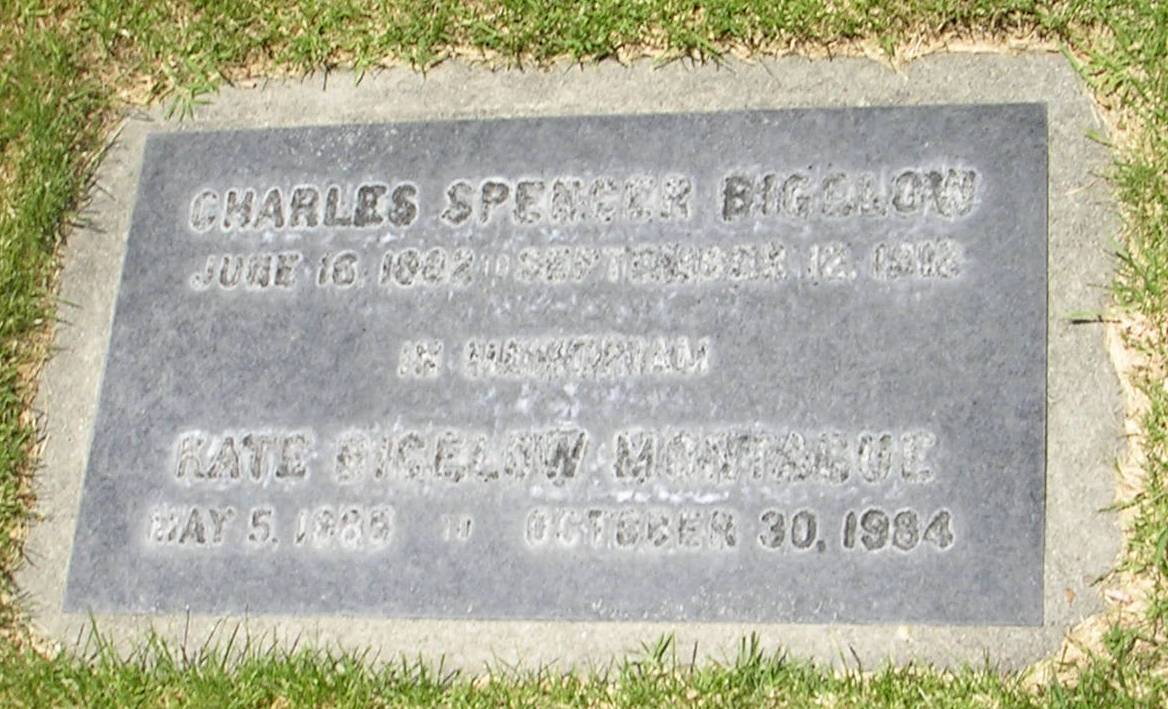
Hazel Margaret Montague, the daughter of Le Roy Montague and Arvilla Hess, was born on 6 October 1886 in Boone, Boone county, Iowa - from a delayed birth certificate.
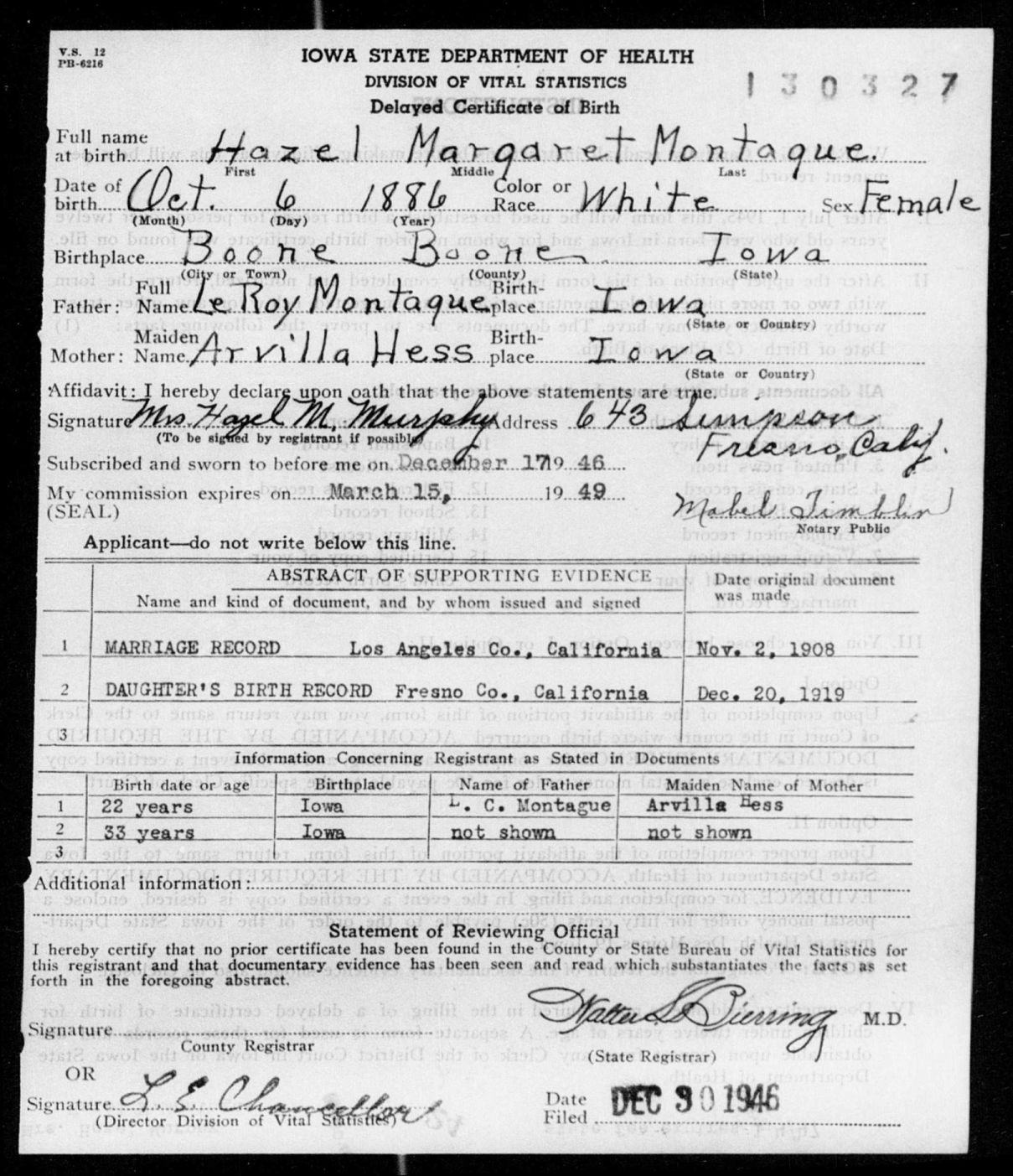
"Los Angeles Orphan Asylum and SchoolTranscriber's Notes: "Columns above represent name, relation, color, gender, birth month, birth year, age, birth place, father's birth place, mother's birth place, . . . months at school, can read, can write, can speak English, . . ."
9th Ward, Los Angeles City
Los Angeles County, Califorinia, A.D. 1900
. . .
291 Montague Hazel Inmate W F Oct 1887 12 Iowa Iowa Iowa At School 8 YYY" - from Los Angeles Orphan Asylum and School.
| Institucion Caritativa (Los Angeles Orphan Asylum, Maryvale)
Mary Pickford, who had made the silent movie "The Foundling" on its campus, was a long-time sponsor. |
Hazel later married Alex C. [J?] Murphy, of Pennsylvania, who was 20 years her senior. In the 1910 census of Fillmore township, Ventura county, California her brother, Lee, was living with Hazel and her family. Her husband, Alex, was a Superintendent at an oil Company. She had a son, Walter E., 7/12, at this time.
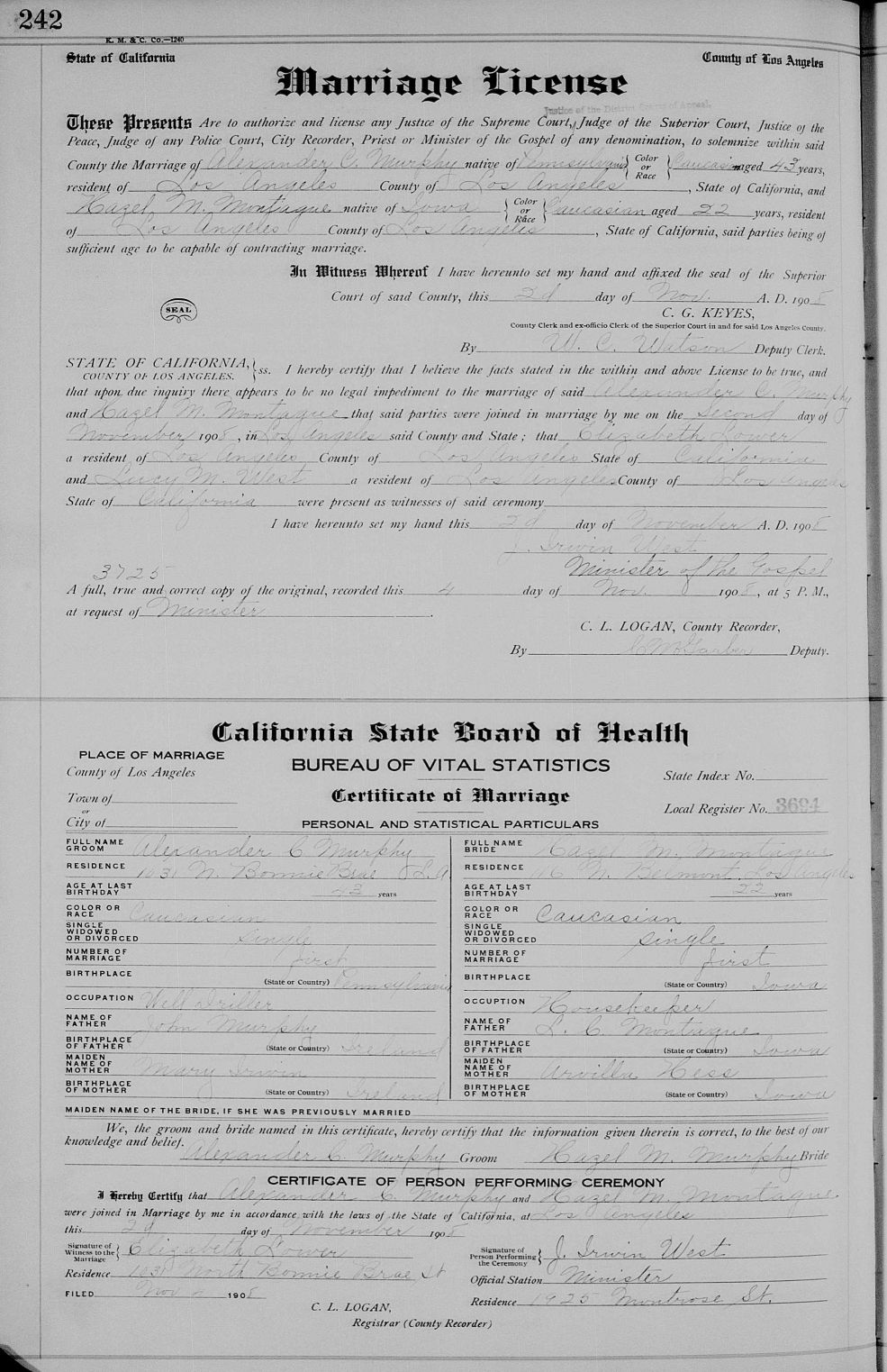
| Ventura County
|
In the 1920 census of township 6, Fresno county, California Alex Murphy, 54, and Hazel, 35, had four children, Walter, 9, George A., 7, Margaret H., 4, and Hazel G., 1/12. Alex was still in the oil business.
In the 1930 census of township 4, Merced county, California Alex Murphy was the manager of a grain elevator. All four of their children continued to live at home.
| Fresno and Merced Countys
|
Anita's Grandfather. He was born on 12 December 1890 in Boone county, Iowa. I don't have a birth certificate for Lee and the family broke up before he could show up on any census with Leroy and Arvilla. The same can be said for his sister, Hazel Margaret Montague, but she had a delayed birth certificate and a marriage certificate that confirmed she was the daughter of Leroy C. Montague and Arvilla Hess. In 1910 Lee was living with Hazel and her husband, Alex Murphy, as Alex' brother-in-law.
Lee Roy moved to Inyo county, California with his parents between 1890 and 1892. After his mother died, and certainly by 1892, the family was split up, his father moved to the Los Angeles area, and Lee boarded out.
In the 1900 census of Taboose, Inyo county, California as Le Roy Montague, 10, a boarder, born in Iowa. He was living in the house of Charles Waller, 40, his wife, Sarah, 40, and daughter, Katie, 15. Taboose was on the other side of the valley from Blackrock. Lee's date of birth was shown as December 1889 [sic]. Had the Wallers taken in Lee immediately after his mother's death, when he was only 2 years old? Waller, by the way, was the enumerator in the census. He was also a compositor, that is a type setter for a newspaper. This was probably either the "Inyo Register" of Bishop, which was to the north of Taboose, or the "Inyo Independent" of Independence, which was to the south. Charles Waller was originally from England. Lee's brother Guy also remained in the Owen's valley, working on a dairy farm.
| Taboose
There was a pioneer stage coach station called Taboose located where the 395 highway today crosses Division creek. The highway today crosses the Taboose creek at Black Rock Springs road. There is a camp ground located at this spot today, pictured at the left. The community of Black Rock was at this point, on the east side of the highway. There was also a "Taboose Ranch" about 12 miles north of Independence in the 1870s, in the vicinity of Blackrock. There are even references to a Taboose racetrack. Apparently government surveyors borrowed the word for today's Taboose pass and Taboose creek. The "Inyo Register" newspaper of 1909-1911 had a column dedicated to the news of Taboose, treating it as a kind of suburb. There is also a street called Taboose Lane in Bishop. |
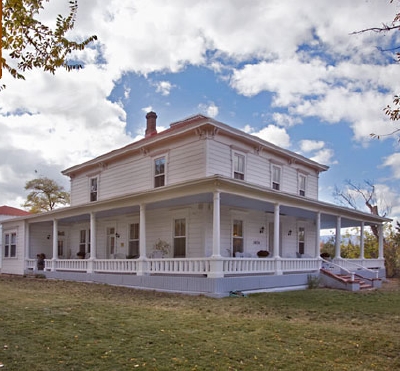 It's difficult to say when the next occurred, it might have been before or after Leroy lived in the Waller's home, as noted above, but according to his son, Lee grew up on the Caughlin ranch near Reno. Here he was treated almost as a son by the family. There is a famous Caughlin ranch in Reno, just south of today's I-80 highway, and west of the 395. It was a considerable estate now being subdivided into suburbs. The old ranch house is pictured to the right. This historic home was built in 1851 in Virginia City, Nevada, then moved to the corner of Mayberry Drive and McCarran Boulevard in Reno, Nevada in 1901. It was the home of Nevada Pioneers William and Crissie Caughlin. William's parents were from Ireland, though he was born in Australia in 1847. His parents subsequently moved to California
It's difficult to say when the next occurred, it might have been before or after Leroy lived in the Waller's home, as noted above, but according to his son, Lee grew up on the Caughlin ranch near Reno. Here he was treated almost as a son by the family. There is a famous Caughlin ranch in Reno, just south of today's I-80 highway, and west of the 395. It was a considerable estate now being subdivided into suburbs. The old ranch house is pictured to the right. This historic home was built in 1851 in Virginia City, Nevada, then moved to the corner of Mayberry Drive and McCarran Boulevard in Reno, Nevada in 1901. It was the home of Nevada Pioneers William and Crissie Caughlin. William's parents were from Ireland, though he was born in Australia in 1847. His parents subsequently moved to California
Soon after Lee Roy moved back to California. In the 1910 census of Fillmore township, Ventura county, California as Leroy Montague, a 20 year old single man, born in Iowa, who was working on the oil-wells as a tool dresser. He was living with his sister, Hazel, and her husband, Alex Murphy. At this time his father, Leroy C., and his brother, Guy, were living in Inyo county, though not together.

According to Lloyd Montague, as a young man his father moved to Bakersfield and worked for a time in the local oil fields. I assume this was after his time in Ventura and probably occurred at the same time Hazel and Alex Murphy moved north to Fresno.
Lee R. Montague, a 26 year old Line man for the Pacific Power Corporation, living in Mono Lake, California registered for the draft on 5 June 1917. He was a single man, born on 12 December 1890 in Boone, Iowa. He claimed that he was the sole support of his father. I didn't know they had any contact after Leroy left his family. When asked if he was claiming an exemption from the draft his response was, "In so far as my services may be necessary to the public service in which I am employed." That is, his power line work might be too important. He was of medium height and slender build, with brown hair and eyes.
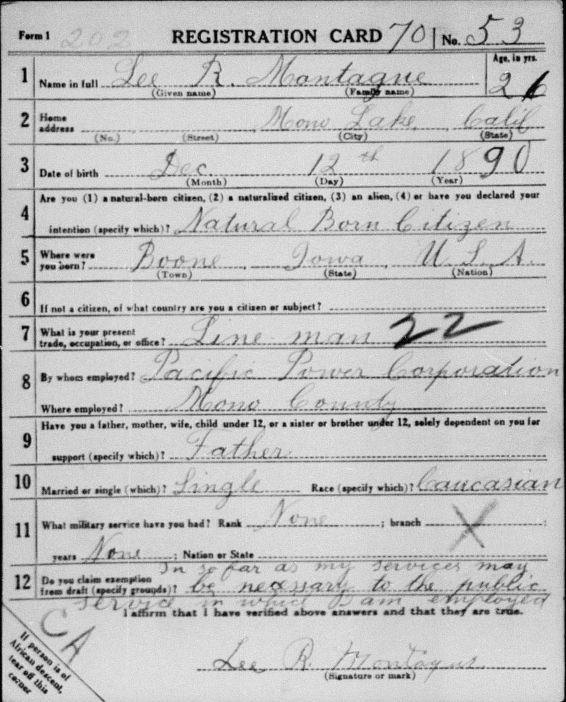
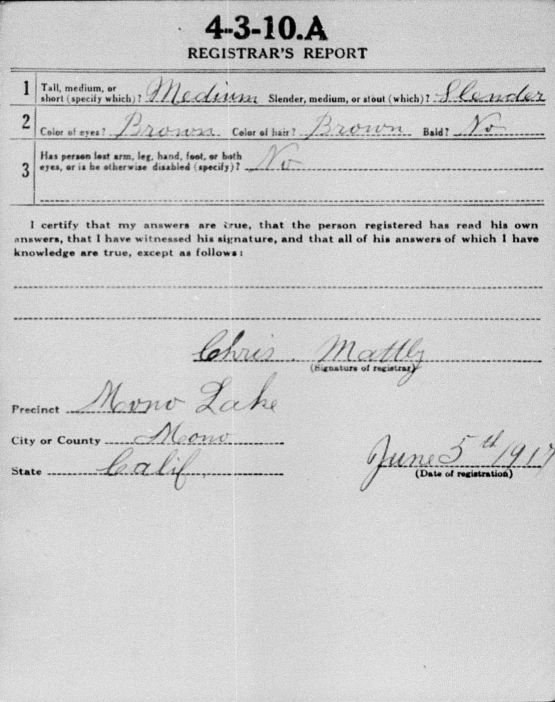
Lee served in the Army during World War I, having enlisted in Bridgeport, Mono county, California on 23 September 1917. According to his son, Lee was stationed at Camp Kearny, California. This was in San Diego county on land that now makes up Miramar Marine Corps Air Station.
The document below indicates Lee was drafted on 4 October 1917 [sic] and assigned to Company A, 160th Infantry Regiment (7th California) per order '19, SO 48' of the Headquarters, 91st Division, at Camp Lewis, Washington. The 91st, the 'Wild West' division, was initially in charge of training young men from the eight western states. At first, the flow of men was turned directly into the various skeleton organizations. Later the increasing flood was directed into the 166th Depot Brigade, from which, as demands required, men were drawn to fill up the various units; see below. The 160th was originally constituted in 1885 as the 7th California Infantry of the Home Guard. It was drafted into Federal Service on 5 August 1917 and redesignated at the 160th Infantry of the 40th Division.

The following is from the "Initial Muster Roll of Company 24 of the 166th Depot Brig. [Brigade]" of 31 October 1917. The role of depot brigades was to receive and organize recruits, provide them with uniforms, equipment and initial military training, and then send them to France to fight on the front lines. The part extracted below lists of "Men transferred with Service Records to 40th Div. Camp Kearney, Linda Vista, Cal. Per S.C. #48 October 16, 1917. Left Co. Oct. 18, 1917."

Something must have happened because Lee Montague was discharged from Company A, 160th Infantry on 10 December 1917 on SCD [Service Connected Disability] per 2nd Ind Hq [Second Infantry Division Headquarters] 40th Division of 7 December 1917.

| Camp Kearny
Naval Air Station Miramar (now a Marine Corps Air Station) was built on the site of Camp Kearny. |
In the 1920 Census for Homer township, Mono county, California as Lee R. Montague, born in Iowa, as a 27 year old foreman on a farm. In the census his father was claimed to be from France, speaking the language as his mother tongue[!], though his mother was born in Iowa. Was this a practical joke on Lee's part? Homer was a gold mining community near Mono Lake.
Lee loved to gamble, but did not drink, and was an avid hunter. He detested labor unions because he felt everyman should stand on his own record and be rewarded accordingly. He would not take a Social Security pension for the same reason - a man should stand on his own.
Lee Roy married Clara Ann Wells, of California, in 1928. They lived in Bishop, Inyo county, California, located in the Owen's Valley, and had two children, Lloyd and Margaret. I'm told that for the 'lying in', Clara went to Riverside, where the medical facilities were better and her parents were located, and Lloyd was born there.
Lee subsequently went to work for the Southern Sierra Power company as a line patrolman, back in the Owen's Valley, based in Lee Vining, Mono county, California. His job involved keeping the power transmission lines operational throughout their routes through the Sierra Nevada mountains. When the lines went down during winter storms, he would patrol on skis until he found and repaired the break. Lee's wife, Clara, wrote the following letter on 4 February 1985 commenting on a book that mentioned Lee.
"Dear Mr. LaBraque -Those who knew Lee Montague told his son, Lloyd, that his feats of endurance on winter patrols were amazing.I have just read "Man From Mono". Your stories brought back many memories - especially your patrolling stories including Lee Montague.
Lee Montague and I (Clara Wells) were married in 1928. He was working as a patrolman on the power line from Control Station, Bishop, over the White Mountains (Silver Canyon) to Nevada. We lived at Laws. He told me many stories about his days at Mono and how George LaBraque taught him to ski.
He told about skiing home late one dark night and heard the panting of animals coming toward him. His thought was wolves! Finding a club was impossible and he skied on hoping for the best until the panting reached him --- his dogs had come to meet him --- It was a happy reunion.
Then on winter nights he told of skiing to the Farrington Ranch to visit Ethel. (They were good winter friends but rarely spoke during the summer). Again his dog (I wonder if it was Bingo) would follow and sit on a snow back looking thru the window during the visit. Then the many spills he took when his following dog stepped on his skiis!
Lee loved your little Lily. He said she was the most beautiful child he had ever seen. Lee passed away in 1970. I have remarried.
I have always felt close to the Mathieu family. We grew up together. John and I entered the first grade together and graduated from high school (1925) together. Frank was my brother, Bud Wells, age and August brother Lloyd's age. We remember Pete as the baby. I remember his mother visiting our first grade carrying him in her arms and all the children taking a peek at him in his blanket. We were all so sorry when Mrs. Mathieu passed away.
Again my thanks for your stories and especially those including Lee and his patrolling. That chapter will mean a lot to his son Lloyd, now a retired Navy Captain living in San Diego and to his daughter Margaret Triscuit living in Lancaster, Calif. with her family and teaching school there.
I have mailed copies of "Man From Mono" to both the children.
Thanks also to Lily for a beautiful job. I hope to with with her sometime.
Clare Montague Dinsmore"
In the 1930 census of Township 1, Inyo county as Lee R. Montague, a 36 year old [sic] line man with the power company. Living with him were his wife, Clara A., 22, and son, Lloyd L., 1 4/12. Leroy and Clara had been married two years. Leroy and his parents were from Iowa. Clara was from California, her father from Illinois and her mother from Nevada.
| The Town of Bishop
The first white explorers in the Owens Valley included the mountain men Jedediah Smith in 1826 and Joseph Walker in 1834, for whom Walker Lake in Nevada and Walker Pass in the southern Sierra were named. Perhaps the most famous explorer was John C. Fremont. His 1845 mapping party included the famous scout Kit Carson, along with Ed Kern, and Richard Owens for whom the Owens Valley was named. The City of Bishop came into being due to the need for beef in the new mining camp of Aurora on the California/Nevada border. In 1861 cattlemen drove herds of cattle some three hundred miles from the San Joaquin Valley, through the southern Sierra at Walker Pass, up the Owens Valley, and then through Adobe Meadows to Aurora. Along the way, some cattlemen noticed that the northern Owens Valley was perfect for raising livestock. To avoid the long journey from the other side of the mountains, a few of them decided to settle in the valley. Driving some 600 head of cattle and 50 horses, Samuel Addison Bishop, his wife, and several hired hands arrived in the Owens Valley on August 22, 1861 from Fort Tejon in the Tehacchapi Mountains. Along with Henry Vansickle, Charles Putnam, Allen Van Fleet, and the McGee brothers, Bishop was one of the very first white settlers in the valley. Remnants of the early settlers stone corrals and fences can still be seen nine miles north of Bishop along Highway 395 in Round Valley (barb wire fencing was not invented until 1873). Establishing a homestead, the San Francis Ranch, along the creek which still bears his name, Bishop set up a market to sell beef to the booming mining camp of Aurora 80 miles to the north. One of the residents of Aurora at that time was a young Samuel Clemens who later gained fame as humorist Mark Twain (see Twain's Roughing It for his comments on our area). The cattlemen were soon followed by sheepmen who initially struggled with a lack forage for their stock. By the turn of the 20th century the area around Bishop became laced with dozens canals and ditches feeding water from Bishop Creek and the Owens River to the many farms that had been established where alfalfa, wheat, corn, and potatoes where grown. On May 6, 1903 the town incorporated officially as the City of Bishop. To this day Bishop is the only incorporated city in Inyo County. The town of Bishop continues to hold a grudge with Los Angeles. Between 1905 and 1907 most of the land in the Owens Valley was purchased from farmers and ranchers at bargain prices by William Mulholland, superintendent of the Water Department for the City of Los Angeles under the guise of a local irrigation project. By the time the now famous Los Angeles Aqueduct was completed in 1913, it was to late for valley residents to take any action. The aqueduct, 223 miles long, used no pumping stations just gravity siphons sending water from the Owens Valley to Southern California. With the diversion of water to Los Angeles, the Owens Lake and lower Owens River dried up by 1927 and many valley residents were forced to pack up and leave the area forever. The Owens Valley-City of Los Angeles conflict was the subject of the 1974 film Chinatown, starring Jack Nicholson. Much of the information above was taken from: http://www.bishopvisitor.com/history/index.htm |
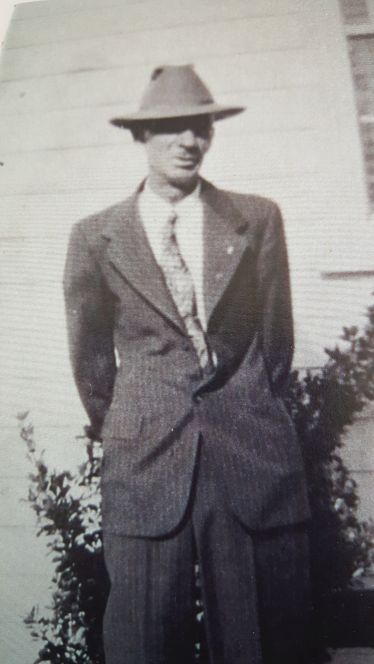 In the 1940 census of Bishop, Inyo county, Calfornia as Lee R. Montague, 48, a Line service man for a private power company. Living with him were his wife, Clara A., 32, a saleswoman at a bookstore, and children, Lloyd L., 11, and Margaret K., 8. They lived at 202 South Smeden [?] street, the same address as in 1935. Close addresses are South Main, Clarke and Short, all streets that are south of East Line.
In the 1940 census of Bishop, Inyo county, Calfornia as Lee R. Montague, 48, a Line service man for a private power company. Living with him were his wife, Clara A., 32, a saleswoman at a bookstore, and children, Lloyd L., 11, and Margaret K., 8. They lived at 202 South Smeden [?] street, the same address as in 1935. Close addresses are South Main, Clarke and Short, all streets that are south of East Line.
Lee Roy Montague, 47, of 503 East Line street, Bishop, California signed up for the draft in 1942. He worked for the California Electric Power company of Riverside. Oddly, his next of kin was not his wife, Clara, but his sister, Hazel Murphy.
Lee Roy and Clara divorced in the 1950's.
Lee Roy Montague had been an AT&T line repairman and moved to Gabbs, Nevada, probably during the mining boom, and remained there in retirement as the town declined. Little was heard from him by the family between his divorce from Clara Wells and his death. One of his son's last memories of his father was of him showing off a set of skinned knuckles he got subduing a drunken miner while serving as a reserve deputy sheriff in Nye county, Nevada at the age of 68. He was only 5 foot 9 inches tall and weighed about 145 pounds, but he had a iron will and constitution.
| The Town of Gabbs
A small town in the middle of no-where in southwest Nevada. The remote hamlet situated in the Gabbs Valley in northwest Nye County ceased being the county's only city on 8 May 2001. The 2000 U.S. Census listed the town's population as 318 and its tax base could no longer sustain a municipal government. The state legislature had disincorporated the community. Gabbs was named for William More Gabb. He was a paleontologist and a member of a survey team in California and Nevada in 1862-67. Several of his colleagues surveyed and mapped the area now called Gabbs Valley. While apparently never seeing the valley that bears his name, Gabb described fossils that were collected there. The community of Gabbs is a product of the 20th century and owes its existence to the discovery of major brucite deposits in Gabbs Valley in the late 1920s. In fact, the town that sprang up in the mid-1930s was first named after the magnesium-bearing mineral. Brucite production grew slowly, then boomed with the onset of World War II and the need for magnesium in the production of defense weaponry. The mineral ore was transported to the Basic Magnesium, Inc. (BMI) plant in the fledgling town of Henderson south of Las Vegas. By the end of 1942, hundreds of workers and their families lived in new town sites named North Gabbs and South Gabbs. The Korean War and the opening of a new BMI plant in 1951 spurred the town's growth. Gabbs acquired city status on March 29, 1955 when the area mines were still operating at full capacity. The small city fared well for many years and at its peak may have reached 1,000 residents. The land here is so desolate and lacking in population that the Navy uses it as a air combat training range. |
Lee died on 14 September 1960 in the town of Gabbs, at the age of 70, as the result of an industrial accident in a mine mill.
"Deaths MontagueHe was buried in the East Line cemetery in Bishop, Inyo county, California.
In Reno, Sept 12, 1960, Lee Roy Montague, father of Lloyd . . ." - from the "Reno Gazetter-Journal" of 14 September 1960

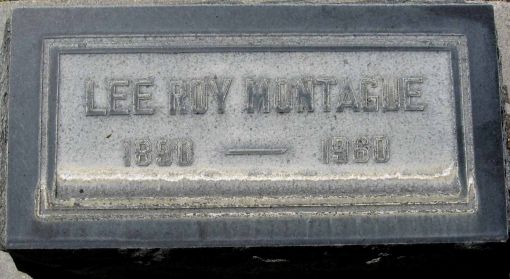
Clara married Robert Dinsmore on 19 July 1959, but remained in Bishop until late in life when she moved down to Escondido, just north of San Diego where he son Lloyd lived, to settle in a retirement home. She died in about 2000.
Lee's children were,
(26) Lloyd Lee Montague (1928)
(26) Margaret Kay Montague (1931)
Anita's Father, and my Father-in-law. He was the last surviving male-heir of the (22) Zenas Montague (1778) line. Lloyd Lee Montague, the son of Leroy Hess Montague and Clara Ann Wells, was born in Riverside, California on 26 August 1928, where his mother removed for the delivery. However, he grew up in the small town of Bishop, California, in the High Sierras, just south of Mammoth mountain. In the 1930 census of Township 1, Inyo county as Lloyd L. Montague, 1 4/12. For his entire youth he lived at 306 East Line street. The house still exists, now a dentist's office.
Lloyd attended the Bishop Union Grammar School from September 1933 to June 1941. Below is a typical view of a lonely, high desert landscape, in the springtime covered in wild flowers.

Below, to the left, are Margaret and Lloyd Montague. To the right, in the front row, are Lloyd and Margaret Montague, and in the back row, are Lloyd's father, Lee Roy Montague, his uncle, Marvin Chester "Bud" Wells, his grandfather, Albert Lloyd Wells, and his grandmother, Gertrude Nelligan Wells.
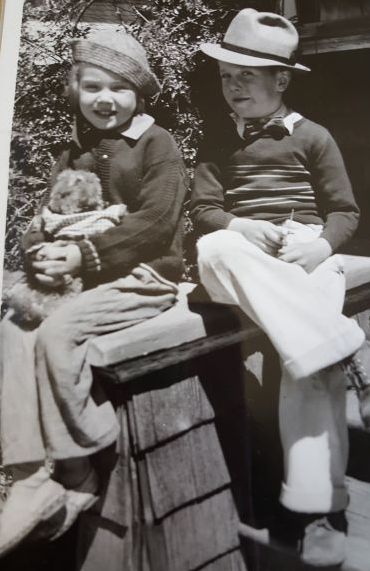
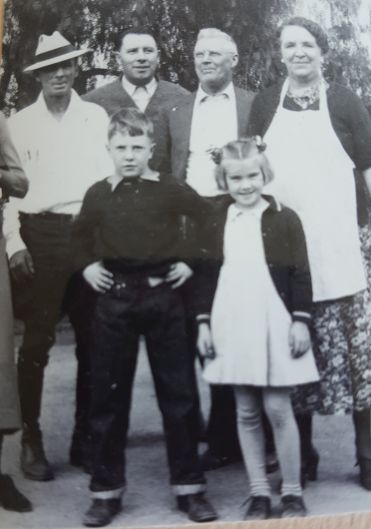
At the age of 8 or 9, during a summer spent down in Riverside where the family frequently spent the summer, Lloyd was introduced to flying by his uncle, Marvin Chester Wells. He twice took Lloyd flying in an Aeronca. From Lloyd's description of the aircraft it was the famous [infamous] C-3. It was not, as might be expected, the birth of a love of flying, but more a demonstration that, though his mother was opposed to him flying, he could do what he wanted to.
| Aeronca
|
In the 1940 census of Bishop, Inyo county, California as Lloyd Montague, 11. He was living at 202 South Sneden street with his parents, Lee R. and Clara A. Montague. His sister, Margaret, 8, was also at home.
Lloyd attended the Bishop Union High School from September 1941 to January 1945.
In the Boy Scouts, Lloyd achieved the rank of 'Life,' the next highest to Eagle, in 1942 at the age of 14, and held the positions of Patrol Leader and Den Chief. He reports that in the high & dry atmosphere completing the Swimming merit badge stymied him. While he was working towards his Eagle rank, in the atmosphere of war his attention changed and he did not finish.
As a boy, Lloyd used to tramp through those mountains, first as a Boy Scout in BSA Troop 259, and later with the United States Geological Survey. At Lloyd's funeral I talked with Danny Young, his friend during this latter period. He had accompanied Lloyd on these surveys, climbing the peaks and wrestling with the pack mules. Danny noted that both he and Lloyd despised their boss who was, in Danny's opinion, both bull-headed and ignorant. Danny claimed this boss could not accurately read a topographic map and consistently chose the worst, most difficult paths up the mountains, despite the sage counsel of his youthful compatriots [now doesn't that sound like an old man's reminiscence?]. The topographic charts of the area in use today owe something to his early surveys. Below is a sample of such a chart for the Bishop area.

| US Geological Survey
The United States Geological Survey was established on March 3, 1879, within the Department of the Interior. It was charged with the responsibility for "classification of the public lands, and examination of the geological structure, mineral resources, and products of the national domain." In the 1930's the Survey subsisted, even grew, on funds transferred from agencies formed to combat the depression by the Franklin D. Roosevelt administration. The Tennessee Valley Authority turned to the Survey to meet its need for maps of the entire valley and for a much expanded program of stream gaging throughout the basin. Time constraints on the mapping assignment provided the Survey with an opportunity for a full-scale test of the use of aerial photography, with which it had been experimenting since 1904, and ultimately, with the aid of newly developed photogrammetric equipment and techniques, led to a complete revolution in mapmaking procedures. The Public Works Administration began allocating funds in August for topographic mapping, water-resources projects, and much needed safety work on the public lands that by November 1 amounted to more than $3.7 million, more than the total of all funds for the Survey's 50th year. By the end of the fiscal year, the funds from other Federal agencies and cooperative funds were four times the Federal appropriation. The grants from the Public Works Administration and the Tennessee Valley Authority could be and were used in part to extend Survey investigations and mapping into new areas and to support research studies. Mineral-resource investigations were made in Eastern and Southern States, extensive studies of the relation of rainfall to runoff and of the magnitude and frequency of floods were undertaken, gaging-station networks with improved structures and instruments were expanded, the topographic-mapping program became a national program, and most of the mapping was done at the needed larger scales. By that time, however, Germany, Italy, and Japan were already perceived to be aggressor nations. Beginning in the mid-1930's, both the Survey and the Bureau of Mines had called attention to the need for strategic-mineral investigations. The need for a national mapping program had been outlined as early as 1934. Strategic-mineral investigations were begun in 1938 with funds from the Public Works Administration. Congress passed the Strategic Materials Act in June 1939 and appropriated funds for strategic-mineral studies in August, only days before Hitler's armies marched into Poland to begin World War II. Topographic mapping of strategic areas in accordance with military priorities was begun in 1940. Geologists, geophysicists, chemists, physicists, petrologists, and paleontologists were all drawn into service, and the Geological Survey reached out to universities and industry to recruit others. The search for needed resources covered not only the United States but also, under the auspices of the State Department or the Board of Economic Warfare, Latin America and other foreign areas. New methods were devised to aid in the search, among them airborne magnetic surveying, which the Survey developed in cooperation with the Navy. The Topographic Branch continued the strategic mapping program on behalf of the War Department until the threat of invasion passed. |
 World War II started for America when Lloyd was 13 years old. Eager to join the war effort, his goal was to finish High School in three years by attending the Army and Navy Academy (ANA) in Carlsbad, California, pictured to the right. He attended summer sessions there in 1944 and 1945. ANA is a college-preparatory, military, residential school for young men in grades 7 through 12. Founded in 1910, the Academy has been at its current location on the beach in Carlsbad since 1936. It is about 35 miles north of San Diego and about 80 miles south of Los Angeles.
World War II started for America when Lloyd was 13 years old. Eager to join the war effort, his goal was to finish High School in three years by attending the Army and Navy Academy (ANA) in Carlsbad, California, pictured to the right. He attended summer sessions there in 1944 and 1945. ANA is a college-preparatory, military, residential school for young men in grades 7 through 12. Founded in 1910, the Academy has been at its current location on the beach in Carlsbad since 1936. It is about 35 miles north of San Diego and about 80 miles south of Los Angeles.
Lloyd wanted to become a Marine so that he could fight the Japanese in the Pacific. He was seduced, I suppose, by the many Hollywood war pictures that glorified the tough-fighting Marine Corps. However, Japan surrendered on 15 August 1945 before he could complete his plan. He decided, none the less, to join-up. He and his cousin, Lyndon "Tex" Holland, who was only 16, went down to Los Angeles to find a recruiter. Arriving late, they checked into a hotel. The hotel staff was concerned about their obvious youth and called the police, believing the boys to be run-aways. The police took the boys into custody and told them they had to get a telegram from their parents letting the police know that their stay in Los Angeles was okay. In the meantime a bus would be on the way to take them to juvenile hall for "safe keeping." The boys kicked their heels in the police station for a while, then, tired, mad and just a little embarassed, they slipped out and spent the night in an "all-night" movie theater. The next day, afraid that the police would arrest him for "breaking out" of the police station, Lloyd decided he'd better join-up as quickly as possible. The first recruiter he came to was the U.S. Navy. "Tex" went home and later joined the Army Air Corps.
The Navy recruiter invited Lloyd to join under the V-5 program. This was an aviation program that included a two-year military scholarship. Lloyd accepted and went off to the University of Southern California in Los Angeles, where he studied Mechanical Engineering from March to June 1946. At this time he served as an Apprentice Seaman, getting an honorable discharge in October 1946, when he joined the NACP program, see below. He attended USC again from October 1946 to January 1948.
| Navy V-Programs of World War II
The V-Programs were the Navy's attempt to recruit and train the enormous number of men needed to fight World War II. The V-1 program was a non-militarized pre-induction program. V-5 was the Naval Aviation Cadet (NAVCAD) program. V-7 was a program for regular duty ensigns. V-12 was designed to train reserve officers. Each offered two years of college education. To enter V-5, the candidate had to pass a preliminary test, usually given at the local recruiting station. It included written, oral and physical exams. If the prospective cadets passed, they were sent to a Naval Aviation Cadet Selection Board where they were given another, harder series of written, oral and physical exams. Afterwards they would be sworn into the active duty Navy as Cadets. There was usually a waiting period, spent at home, for orders to report for duty. This could be a matter of weeks or months. Some cadets received a pre-primary flight training syllabus known as the Civilian Pilots Training (CPT), later renamed War Training Service (WTS). In this they gained experience by flying the civilian J-3 Cub, receiving 35-40 hours of flight time. This appears to have been, in reality, a holding period while room in the training pipeline opened up. For their initial duty the cadets reported to the participating college of their choice where they were quartered in the schools' dorms. Some time during this period the cadets attended Pre-Flight school. It was scheduled for a three-month period of a half-day of ground school, where they learned about engines, the physics of flight, navigation, and blinker, semaphore and Morse code, and a half-day of physical education. They also learned to march and comport themselves with some semblence of military bearing. |
While at USC, Lloyd resided as part of the Navy ROTC unit.
While many of the aviation cadets in the V-5 program elected to continue taking college courses through the summer, and finished their coursework in 18 months vice 24, Lloyd decided to take part in a summer program to gain experience in Naval Aviation. He worked in a Patrol Squadron at NAS San Diego, California as a mechanic on the P2V Neptune, a relatively new twin engine reconaissance/anti-submarine aircraft. While this was valuable experience, it ended up causing Lloyd trouble. Two things led to this. First, the Navy changed the Aviation Cadet program. While the V-5 cadets had been in the active duty Navy throughout their college and flight training, the 'cadets' of the new Naval Aviation College Program (NACP), begun in August 1946, were to be civilians during their two years of college study, though all their college costs continued to be covered and they were provided $50 a month in pay to cover room and board. They were to go on active duty only when they started their flight training. Those cadets making the transition from the V-5 program to the Aviation Midshipman Program had to be officially discharged from the Navy before continuing with the program.
At the end of the summer of 1946, after completing his term with the P2V squadron, Lloyd waited to be discharged so he could go back to school under the new Midshipman program. However, the Navy had kept a large number of men on active duty for support duties during the Bikini Island atom bomb tests and, those completed, there was a large backlog of men to be discharged. Lloyd was placed at the end of the line and wasn't able to get discharged and back to school until a month into the semester. With a heavy course load, 21 semester hours worth, he admitted that he was behind all semester long.
| Naval Aviation College Program (NACP)
This program, also known as the 'Holloway Plan' after the current Chief of Naval Operations, was designed to provide the Navy with qualified pilots in the post-World War II period following the loss of a large segment of experienced naval aviators returning to civilian life following the end of World War II. It offered to pay for two years of college and training as a naval aviator in exchange for a service obligation.
"The first stage was familiarization and soloing. The last was formation flying. The "in between" stages were for gaining confidence in the flying and receiving instructions in every thing you could do with the plane, such as slow rolls, snap rolls, loops, split S's, spins, slips, stalls and a variety of other things including night flying. Also included in these stages were rides with "check" pilots who would either approve your techniques or give you a "down". A "down" was a fail to pass the check and required a second check ride. Another "down" meant that you would have to take extra instruction in that stage. A third "down" and you were on your way home with a future of a new career in the Army or Navy. "
The NACP cadets were not automatically commissioned. They remained as aviation midshipman and were ordered to the fleet, serving as pilots but not as commissioned officers. After a period of service in the fleet these "flying midshipmen" usually received their commission. The program was in effect between 1946 and 1950. Of the 3,000 Aviation Midshipmen, about 1,800 were designated Naval Aviators. Neil Armstrong, the first man to walk on the moon, was an Aviation Midshipman as was James Lovell. |
Lloyd started flight training in mid-1947 with the old Stearman bi-plane. This must have been at a field near USC since he didn't get to Pensacola until 1948.
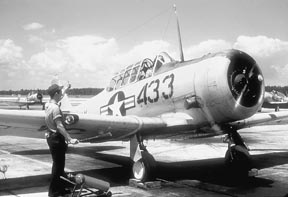 Lloyd completed his two years of college, four semesters at USC, in January 1948. In February 1948 Lloyd arrived for further flight training at Naval Aviation Training Base Pensacola, Florida. His initial training would have been in a ground school studying aerodynamics, weather and navigation. On 10 July 1948 Lloyd 'entered upon flight duty,' in the Navy jargon. His first flight was on 10 August when his instructor, a Lt. Ferguson, flew with him in an SNJ-6, Bureau Number 112274. At right, an SNJ on the ramp at Pensacola. He got 224.9 hours in Basic training before he "hit" the boat for carrier qualifications on 6 April 1949. He got six arrested landings onboard the USS CABOT, which was operating off the coast of Pensacola.
Lloyd completed his two years of college, four semesters at USC, in January 1948. In February 1948 Lloyd arrived for further flight training at Naval Aviation Training Base Pensacola, Florida. His initial training would have been in a ground school studying aerodynamics, weather and navigation. On 10 July 1948 Lloyd 'entered upon flight duty,' in the Navy jargon. His first flight was on 10 August when his instructor, a Lt. Ferguson, flew with him in an SNJ-6, Bureau Number 112274. At right, an SNJ on the ramp at Pensacola. He got 224.9 hours in Basic training before he "hit" the boat for carrier qualifications on 6 April 1949. He got six arrested landings onboard the USS CABOT, which was operating off the coast of Pensacola.
| USS CABOT
USS CABOT, CVL 28, was a light carrier, commonly known as a jeep or escort carrier. She was launched on 4 April 1943 by New York Shipbuilding Company, of Camden, New Jersey. During the war she operated in the Pacific and took part in a number of campaigns. At the end of the war she was placed 'out of commission, in reserve' at Philadelphia on 11 February 1947. She was recommissioned on 27 October 1948 and assigned to the Naval Air Reserve training program where she operated out of Pensacola, Florida. CABOT later decommissioned and transferred to the Navy of Spain where she became the DEDALO. Spain is about to decommission her again and attempts are underway to return the ship to America for use as a memorial and tourist attraction. 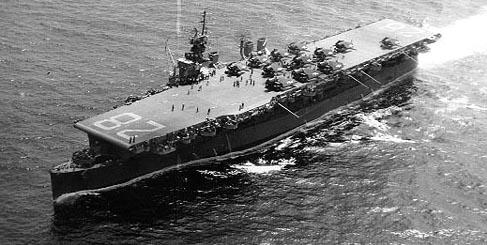 On a straight-deck carrier like CABOT, aircraft that had already landed were parked on the bow. To protect those aircraft from an succeeding aircraft that might miss catching an arresting wire on landing, a retractable barrier was raised about mid-deck. It was made of a strong fabric that could catch an errant aircraft while doing minimal damage to it. Its danger was that an aircraft, executing a wave-off from landing, might catch the top of the barrier with its tailhook. Caught by the barrier, the aircraft would be thrown to the deck with catastrophic consequences. On modern carrier this has been solved by rotating the landing area about 10 degrees to the left. An aircraft that misses catching a wire, called a bolter, can continue forward, taking off again, without endangering the aircraft on the bow. |
Lloyd tells a story about his first night flight in the Corsair. He was used to the green instrument lighting of the SNJ and, when he got into the cockpit, he adjusted the rheostat to ensure that as darkness fell the instruments could still be read. As it got darker, however, he noticed little but a small green flicker. Now airborne, he continued to play with the rheostat, twisting it back and forth, but with no results and he had to fly with a flashlight precariously balanced on his knees to light the instrument panel. He then entered the landing pattern at the airfield to practice night take-offs and landings. As he made his first night approach, the aircraft ahead of him, electing to abort his landing and go-around to try again, powered up the aircraft's big Pratt & Whitney engine too rapidly, induced an uncontrollable torque roll, and crashed in brilliant orange flames right in front of Lloyd's aircraft. Somewhat unnerved, he still managed to complete the prescribed number of night landings. On deck he checked with the ground crew and discovered that the lighting should have been orange, not green. The lights of his aircraft were broken and the green flicker he thought he saw could, at most, have been from the residual glow of the radium coated dial.
Lloyd did his carrier qualifications in the F4U on the CABOT, which was again operating off the coast of Pensacola. The following is an excellent description of a carrier take-off and landing in an F4U by a student pilot, NavCad Fred Blechman.
"With a ten-knot surface wind and the carrier's forward speed, the wind over the deck was approximately 35 knots. The takeoff should be easy. I checked various settings. Full flaps. Cowl flaps open. Hook up. Trim 6 degrees nose right, 1 degree nose up, 6 degrees right wing down. Tailwheel locked. Cockpit canopy open and locked. Shoulder straps and seat belt tight. Prop control full forward for maximum revolutions per minute (rpm). Mixture auto rich. Supercharger neutral. Wings locked. Controls move freely.I watched the Launch Control Officer to my right give me the windup signal with his right arm as he pointed to my engine with his left arm. I advanced the throttle to 42 inches of manifold pressure and applied full toe brakes by pressing down the tops of the rudder pedals. At above 44 inches the wheels would start slipping on the deck, so full power could not yet be used. I held the joystick all the way back to keep the tail from lifting up and possibly digging the tips of the 13-foot four-bladed propeller into the wooden flight deck.
The 2100 horsepower Pratt and Whitney R-2800-18W(C) Double-Wasp 18-cylinder radial engine roared and the whole airplane shook with anticipation as I verified proper engine readings and signalled I was ready with a head nod. (I dared not let go of the stick for a right hand salute, or the tail could come up!) The Launch Control Officer threw his arm forward with two fingers extended, the signal for me to release the brakes and take off.
Surging forward, the Corsair picked up speed and rumbled down the deck. I added throttle to full power -- approximately 54 inches of manifold pressure -- and held a lot of right rudder to counter the torque of the huge engine and propeller sticking out 15 feet ahead of me. Releasing back stick pressure, the tail lifted and I could finally see where I was headed. I aimed for the right side of the deck, lifting off easily before the ship slipped behind, with nothing but rippling water beneath me. A slight right turn cleared my slipstream from the plane landing behind me, as I climbed ahead of the ship at 125 knots to the 800-foot pattern altitude. Since I was just going around to make another landing, I left the flaps and wheels down. At pattern altitude I reduced the throttle setting to 34 inches of manifold pressure, set the propeller to 2300 rpm, and reset the trim tabs for neutral stick pressure.
About a mile ahead of the ship I made a 180-degree left turn, descending to 200 feet for the downwind leg. I dropped my tailhook, unlocked my tailwheel, and set myself up approximately 3000 feet abeam of the ship, fast approaching on my port side as it steamed upwind.
The plane was flying smoothly with the canopy open and locked. The hot Gulf air and the roar of the engine blustered in from both sides of the windshield. Everything in the cockpit seemed A-okay, warm and comfortable as an old shoe as I watched the ship slip past my nose and toward my left wing.
As the straight deck of the light carrier Wright steamed upwind and its wake appeared ahead of my left wingtip, I banked sharply toward the ship's stern and began slowing the airplane down to an approach speed of 90 knots. Check flaps down, wheels down, hook down, tail wheel unlocked. I shoved the prop control forward for full rpm and reset the trim tabs to takeoff settings in case of a waveoff. I set my rate of descent to about 150 feet per minute, maintaining just enough throttle to hold the nose up approximately 15 degrees, hanging on the prop.
I checked my altitude by seeing where the clear, flat horizon crossed the ship's mast above the bridge, since that indicated exactly how high I was above the deck. At approximately the 90 degree position on the base leg I picked up the LSO with his colored paddles on the port fantail. Now the challenge was to keep the ship from getting ahead of me, since it was churning away from me at roughly 60 feet per second (including the surface wind that was trying to drag me even further behind). I watched the horizon crossing the bridge for altitude, and carefully controlled the power and nose attitude for holding around 90 knots -- just a few knots above stalling!
I used a simple technique to properly intercept the ship. I put the left side of the Corsair's nose on the center of the deck at the aft end -- and held it there! If I tried to judge my turn any other way I would invariably get sucked back behind the ship with a straightaway to catch up -- but then I'd lose sight of the LSO under the Corsair's long nose.
There was no luxury of any significant straightaway in landing on those old straight-deck carriers when you were flying a long-nose Corsair in a nose-up attitude. You just couldn't see ahead of you -- only off to the side. We essentially pyloned counter-clockwise around the LSO in order to keep him in sight!
As I got close in, I tried to keep the nose aimed toward the ship's centerline. This was not only affected by the ship's forward motion, but also by the wind over the deck. This wind was seldom straight down the deck, but approximately 15-degrees to port so the turbulence from the ship's stacks and bridge did not appear in the flight path of the landing planes. This made for a very tricky approach and last few seconds...
At this slow speed, just a few knots above stalling, it took a lot of right rudder, even though in a left turn. And you didn't dare add power quickly since the powerful engine turning that large prop could make the aircraft roll uncontrollably to the left -- the dreaded "torque roll."
It took a lot of back stick, considerable power, and right rudder to hang in there. As I approached the ramp in a left turn, the LSO's paddles and my own perception was that I was drifting to the right of the deck centerline. Too much right rudder. I cross-controlled a bit and slipped to the left just as I approached the ramp, and got a "cut," the mandatory command to cut my power and land. I pulled back on the stick to drop the tail so my hook would catch an early wire."
Lloyd rode the CABOT out from Pensacola for the carrier quals in August 1949. The 'fly-on' pilots were the commissioned Ensigns who outranked Cadet Montague. As Lloyd waited for his turn, one of the first pilots to try to get aboard made the mistake, once he got the engine 'cut' signal from the LSO, of holding the aircraft off and, instead of the controlled crash the Navy prefers, floated above the flight deck, snagged the barrier with his tailhook, and crashed in brilliant flames. The next thing Lloyd heard was the 1MC, the ship's general announcing system, "Midshipman Montague, man your aircraft!" He went up on deck and while his F4U was being brought up from the hangar bay on the elevator, the wreckage of the other Corsair was being pushed over the edge. His carrier quals nonetheless went ahead without a hitch, but he does remember something he wasn't prepared for. As the aircraft left the deck on his first launch he heard two loud 'thunks.' High strung already, he wondered whether something horrible had happened to his aircraft. Nothing was apparent so he continued his carrier landings. Later he discovered this noise was nothing more than the oleo stuts of the main landing gear dropping as the aircraft got airborne. Because on a field takeoff the transition to flight was gradual, and on a carrier takeoff the deck suddenly dropped out from below, he had never experienced this before. After completing Advanced phase Lloyd was awarded his Navy "Wings of Gold." He had 344.6 hours by that time.
Lloyd got orders to report to the Commander, Naval Air Forces Pacific, at Naval Air Station San Diego, California. He flew out on an R4D transport aircraft, which was the Navy's version of the civilian DC-3. In San Diego he was assigned to the Fleet Airborne Electronics Training Unit (FAETU) Pacific (PAC), and sent to an electronics course to learn more about the modern avionics then coming into the fleet. In February 1950 he was sent to the Arctic Survival school in Fairbanks, Alaska for a 10-day course - brrr! Lloyd resided at the Navy BOQ from August 1949 to March 1951.
At this time the 'Type' Commanders made squadron assignments for the new pilots. Naval Air Forces Pacific was the Type Commander for the west coast and Naval Air Forces Atlantic, in Norfolk, Virginia, for the east coast. Today such assignments are handled through the Bureau of Personnel (BUPERS) in Washington, D.C. Lloyd was assigned to Attack Squadron Fifty Five (VA-55) in January 1950 where he would fly the AD-4 'Skyraider.' He was still a Midshipman at this point. Later, after completing 24 months of service in that rank, he would be commissioned an Ensign. During this period he lived in Bachelor Officers Quarters, the BOQ, on base. His nickname/radio callsign was "Monty."
In today's Navy a pilot would go through a Replacement Air Group (RAG), a specialized training unit, before joining his fleet squadron. There he would learn about his new aircraft's systems, how to fly it safely, and employ its weapons. In the 1949/1950 timeframe, a pilot went straight to his fleet squadron and they would check him out in his new aircraft. There was a lot he wouldn't learn in this 'catch-as-catch-can' method. His logbook shows flights in FAM (Familiarization), Tactics, Instruments, Bombing (Glide & Toss), Rockets, Gunnery, Air Support and Slow Time [this isn't at all clear unless it was a euphemism for time building]. In his training in the 'Skyraider' Lloyd was required to achieve an average bomb hit score of 50 feet in dive bombing and 150 feet in glide bombing. Neither, he thought, was that difficult to achieve. On 16 April 1950 he flew home to Bishop, California. I'm sure he "beat up the town," that is put on an aerobatic display for his friends and neighbors, when he arrived. By the way, such flights to airfields in or near your hometown are no longer allowed. They both look bad, as a waste of the taxpayers' money, and were dangerous. "Beating up the town" sometimes resulted in tragedy.
While getting ready to deploy for his first cruise in the Western Pacific (WESTPAC), Lloyd would have spent much of his time in Field Carrier Landing Practice (FCLP) at an outlying field and Carrier Landing Practice on the USS VALLEY FORGE. For many pilots getting on and off the carrier was more stressful than combat, and Lloyd agreed. The squadron would have made several short cruises onboard the carrier of the coast of Southern California, learning to work with the ship's crew and deck handlers, as well as with the other ships of the battlegroup.
In May 1950 he deployed with the squadron onboard the "Happy Valley" for what was supposed to be a quiet, uneventful cruise.
| The VA-55 TorpCats in 1950
The squadron was part of Carrier Air Group 5 (CVG-5) with a tail code of 'S.' While the squadron had many home bases during its long career, from 1946 to 1952 it was based at Naval Air Station (NAS) San Diego, now called NAS North Island. The squadron commanding officer from 1949 to 1951 was LCDR Norman D. Hodson. The junior officers (JO's) nicknamed him "Numbnutz," though not to his face. 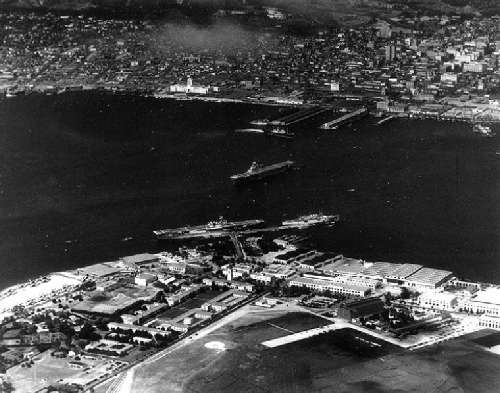 Above is a photo of NAS San Diego in the World War II timeframe. In the foreground is the 'big ramp,' used as a runway, seaplane hangars along the bay, and the carrier USS YORKTOWN tied up waiting to onload her airwing [the aircraft would taxi from the ramp, down the streets of the base, to the carrier and there be craned aboard]. The city of San Diego is in the background. You can see the tower of the County Administration building on the far side of the bay. At NAS San Diego you can see a large tower next to the big ramp. This is the Naval Air Forces Pacific building. The quadrangle at its foot included the Bachelor Officers Quarters. An associated swimming pool is there to this day.
From 1 May to 1 December 1950 VA-55 was deployed onboard the USS VALLEY FORGE, flying the AD-4/4Q, a version of the 'Skyraider,' in the Western Pacific (WestPac). About two months after setting off on this 'peace-time cruise,' on 25 June 1950, at 4 A.M., Korean Standard Time, armed forces of the Democratic People's Republic of Korea launched an attack on the Republic of Korea, setting off the Korean War. The VALLEY FORGE was the only U.S. aircraft carrier in the Western Pacific able to respond [the British carrier, HMS TRIUMPH, also responded at the same time]. VALLEY FORGE was anchored in Hong Kong Harbor, over a 1000 miles from Korea, but after a quick replenishment at Subic Bay, the Philippines, she was ready to launch air strikes on 3 July. |
 Lloyd tells a story of how Kim il Sung saved his Navy career. When the VALLEY FORGE pulled into Hong Kong, it was the first U.S. aircraft carrier to do so. Hong Kong had only recently been freed from Japanese rule and the city was in no way recovered from that brutality. It was in many ways a very different city from today. Most significantly for this story, it was still a bastion of colonial British rule.
Lloyd tells a story of how Kim il Sung saved his Navy career. When the VALLEY FORGE pulled into Hong Kong, it was the first U.S. aircraft carrier to do so. Hong Kong had only recently been freed from Japanese rule and the city was in no way recovered from that brutality. It was in many ways a very different city from today. Most significantly for this story, it was still a bastion of colonial British rule.
As is still true today when a Navy ship pulls in, various organizations in Hong Kong invited Navy sailors and officers to attend official events. The Hong Kong Yacht Club invited three Ensigns to attend a formal 'tea dance' at 4:00 o'clock. Lloyd was one of those selected. He and the two other Ensigns were in their 'choker' whites in preparation for the party, but since liberty had been called at noon, they decided to go ashore to kill time before the party. They hailed a local sanpan to row them ashore. Off-loaded on the British Navy pier, they noticed the China Fleet Club, the Royal Navy's service club.
| The China Fleet Club
In the 1980's land values were rising and the club sold the land. The building was torn down and the China Fleet took over the first 9 floors of a new 23 floor commercial development. The club has since moved back to England. |
The boys decided to enter the China Fleet Club to while away the hours. That day Singapore Slings were the bar special at 50 cents a drink. The first man ordered his chums a round and, since they were three men, two more rounds had to be ordered to return the favor. After those were finished it was still too early to go to the party, so another round was ordered by one of the men, the favor of which had to be returned with two more.
At this point the boys were pretty well soused and they decided to change venues. They got themselves a cab, probably a rickshaw, and told the driver to take them somewhere 'nice.' At the dance hall they were taken to they noticed that the girls were grouped by nationality. They liked the Chinese girls the best, plus they had those tight slit dresses. After some 10-cents-a-dance action, they decided that their planning had been poor, because if they were going to a tea dance they'd better bring someone to dance with. So they invited their new girlfriends and climbed back into the cab, which had been waiting for them because the cabbie knew a good thing when he saw it, and went to the Yacht Club.
The Yacht Club party was a formal affair and there was a receiving line which the drunken and disheveled Ensigns negotiated with their girls in tow. Once inside they realized their re-jiggered plan was misguided because they were any number of yound English women there availalbe for dancing. What surprised them was how quickly the party ended after they arrived.
The next morning, back onboard ship, Ensign Montague was awoken by the Duty Officer who told him that the Squadron's Commanding Officer, Norm Hodson, old 'Numbnutz,' wanted to see him ASAP. The Skipper proceeded to read him the riot act because the Admiral was demanding to see him. Once in front of the Admiral our Ensign was informed that the American Consul General, the Governor of Hong Kong, and the Hong Kong Yacht Club, were livid because three drunken American Ensigns had brought a trio of prostitutes to the tea dance. Lloyd could do little but admit his failings. He and his buddies were put into 'hack,' which is something like confinement to quarters, for the next two weeks. In a peace-time Navy this event, and the official reprimand entered into his records, held the very real possibility of ending Lloyd's nascent career.
It is at this point, in fact the very next morning, that Kim il Sung did Lloyd a huge favor by invading South Korea. In this new atmosphere of war such minor peccadillo's amongst the snobby Englishmen, who clearly couldn't take a joke and had it coming, was more amusing then condemning. The trio still served out their time in hack, but their records were cleared.
|
Other squadrons onboard VALLEY FORGE were VF-51, the 'Screaming Eagles," and VF-52 flying the F9F-2 'Panther,' an early jet fighter. Below, an F9F-3 of VF-52 taxies forward on USS VALLEY FORGE to be catapulted for strikes on targets along the east coast of Korea on 19 July 1950. Note details of the ship's island, including scoreboard at left. 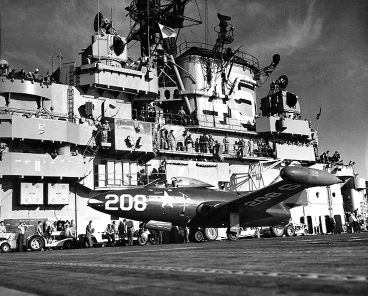
VF-53 and VF-54, the 'Hell's Angels,' below to the right, were flying the F4U-B 'Corsair.' By the way, the numbering of these fighter squadrons was a VC-3 flew the F4U-5N and the AD-3N, both configured with a radar pod to fight at night. VC-11 flew the AD-3W, a three-seat version of the 'Skyraider' that served as an early-warning aircraft. It had a large radome underneath the fuselage. HU-1 flew the HO3S-1, the first Navy helicopter - think of Mickey Rooney in "The Bridges of Toko-Ri." MAW-1 HEDRON-1 flew the F4U-5P, a long range reconaissance version of the 'Corsair.' |
USS VALLEY FORGE arrived on station off the southern coast of Korea and with HMS TRIUMPH participated in the first carrier action of Korean War. VF 51 aircraft from Valley Forge shot down two North Korean aircraft. The action was also the first combat test of F9F Panther and AD Skyraider. VA-55 participated in these first combat strikes. The squadron flew its AD-4 Skyraiders on strikes against airfields, supply lines and transportation facilities in and around Pyongyang, the capital of North Korea, which were beyond the range of Air Force bombers in Japan. The 16 dark blue AD-4s carried a pair of 500 pounders and six 100-pound bombs each, and rolling in from 7,000 feet destroyed or damaged aircraft, hangars and barracks buildings. A fuel farm took a direct hit, creating a memorable conflagration, and the runway was cratered. Four VA-55 ADs sustained hits that day but survived the assault. The Skyraiders' baptism under fire was a notable success. An F9F-3 from the VALLEY FORGE achieved a kill against a YAK-9 [a propeller driven Soviet fighter looking somewhat like a P-51 Mustang] the same day. Ensign Montague flew two combat missions on the 3rd and two more on the 4th, in which a bridge span was knocked out and 12 locomotives were destroyed. The planes were not immune to enemy fire and again many took hits in what was proving to be a sturdy airframe.
VALLEY FORGE then steamed south to replenish at Buckner Bay, Okinawa. The ship's weapons magazines, while vast, were being depleted rapidly by the frantic pace of operations. As the magazines were emptied, even the odd ordnance which had been stored deep in the ship for years came up for use. Lloyd reports carrying depth charges, fused for operations overland. He had never delivered such an un-aerodynamic piece of ordnance and could only do his best to 'ball-park' the delivery. To make matters worse, the supply situation in 1950 was chaotic. There were no ammunition ships available and few oilers, necessitating the long transit to Okinawa. Mail service was also non-existent, clearly showing the extent to which America had been caught flat-footed by the North Korean invasion.
On the 18th VALLEY FORGE was back on station, northeast of Pohang. By the end of July U.S. and South Korean forces had retreated to a defensive position around the port of Pusan, in the extreme southeast of the country.
Lloyd described one mission where the engine's rocker panels got shot away. As he went 'feet wet' after the mission another aircraft radio'd him that he was streaming black smoke - made from the oil draining out of his engine. USS BOXER was closer than VALLEY FORGE so Lloyd set up to land there. At the 90 his oil pressure dropped to zero. He made a quick decision. Standard practice would be to level the wings and ditch the aircraft - no one wanted a dead stick landing onto a crowded flight deck. However, the water was deadly cold and Lloyd figured if he could set the power, and leave it alone, he could keep the engine turning. He thought that from his positon 75% power would set him up properly for an 'OK' pass. So, leaving the power set, he followed the LSO's direction and, at the cut signal, chopped power. The engine immediately froze, but he settled into the wires and was home safe.
In one attack Lloyd was targeting a locomotive. Its engineer, seeing his danger, attempted to hide in a tunnel, but misjudged his speed and was unable to stop until outside in the clear again. In another, Lloyd was called in against a machine gun nest which was sweeping an allied position. He was carrying napalm and rolled in on the position planning, as was normal with this ordnance, to drop early and let the jellied gasoline spill forward, towards the enemy position. As he stablized in his dive the gunner noticed him and elevated his machine gun to fire at Lloyd's aircraft. To Lloyd's surprise, the gunner would not abandon his position even though, in Lloyd's mind, he must know what was coming. This was one of those moments when he most keenly identified with his foe.
On 12 September the squadron participated in strikes against targets in and around Inchon and Seoul, Korea in preparation for MacArthur's famous landings at Inchon. On the 15th the amphibious assault began with more strike coverage flown by VA-55. This attack, well behind North Korean lines, broke the back of the invasion and by the 25th the North Koreans were in full retreat. The VALLEY FORGE also fought off the north coast of Korea, covering the amphibious assault on Wonson harbor.
In one of the funnier stories of the war, aircraft from VA-55 had received help from a Marine air base, callsign "King 7," (K-7). I believe this was within the Pusan perimeter. The Navy pilots wanted to thank the Marines so they came up with the idea of filling a store with ice cream and other treats, attaching it to one of the AD's bomb stations, and dropping it off at the Marine base enroute to one of their real targets. The skipper liked the idea, but they decided to put this store on the wing of one of the poorer bombers so that the 'aces' didn't waste a bomb station. As they approached the Marine base the Navy pilots radioed the Marines that they had something for them to show how much they appreciated the help. As he made his low, slow approach however, our "poor" bomber messed up his station selection and, instead off dropping off the ice cream filled store, he pickled a bomb. Luckily it wasn't armed so it didn't go off. The Navy pilots, however were ignorant of the mistake. They were puzzled and annoyed when they returned to the ship and received a blast from the Marine Corps, who didn't appreciate their thanks. This also makes you wonder about that North Korean soldier, hunkered down to await an American bomb, only to be showered with ice cream.
Below, a single AD-4 from the squadron inflight and "a formation of AD Skyraiders of VA-55 off VALLEY FORGE unleash Naval Aviation's version of a broadside, a fusillade of 5-inch rockets, against North Korean field position." The latter photo is dated 24 October 1950.
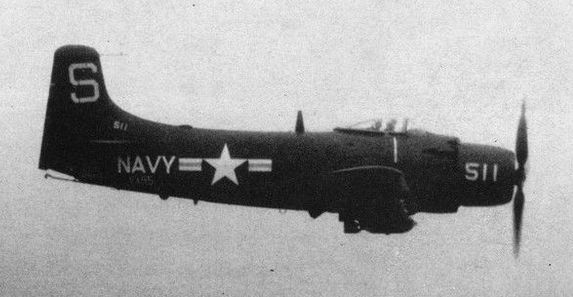
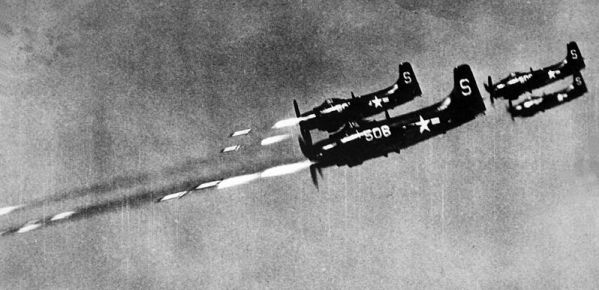
 When not 'on the line,' VALLEY FORGE refitted and resupplied at Buckner Bay, Okinawa, and Sasebo, Japan. While rearming is done at-sea today, it appears most rearming was done inport in 1950, probably due to the scarcity of ammo ships at the time. Refueling, on the other hand, was done at-sea. At right VALLEY FORGE sailors line up for the liberty boat in Sasebo. I wonder what the liberty was like?
When not 'on the line,' VALLEY FORGE refitted and resupplied at Buckner Bay, Okinawa, and Sasebo, Japan. While rearming is done at-sea today, it appears most rearming was done inport in 1950, probably due to the scarcity of ammo ships at the time. Refueling, on the other hand, was done at-sea. At right VALLEY FORGE sailors line up for the liberty boat in Sasebo. I wonder what the liberty was like?
By late October 1950, the Korean War was considered over. North Korea's invasion had been defeated, the shattered North Korean People's Army (NKPA) was fleeing north toward the Yalu River border with China, pursued by victorious United Nations troops, and talk of Christmas homecomings raised hopes for a swift peace. The fast carrier force retired to Sasebo, Japan as the need for their services ended.
Elements of the Chinese Army had begun to cross the Yalu river as early as 16 October, but they were unobserved. On 1 November they began a massive offensive. Two Chinese People's Liberation Army (PLA) divisions, numbering over 300,000 men, entered Korea practically undetected, rallied the NKPA, and together they trapped the outnumbered allies in a massive double envelopment.
VALLEY FORGE departed Sasebo, Japan on 5 November and proceeded to Korea in response to "an emergency request from UN ground forces for air support needed as a result of Chinese communist intervention in the Korean War." On 9 November the Air Force and Navy commenced attacks on the Yalu river bridges in an attempt to halt more Chinese troops from entering North Korea. Previously off-limits to attack, even now only the 'Korean' side of the bridges could be targeted. Due to political considerations bombing runs could not be made from south to north for fear bombs might fall on China, propelling her to formally enter the war. The high escarpments rising along both sides of the river made the west-east approaches to the bridges highly predictable and rendered the attacking aircraft easy targets for enemy gunners. Also, once the gunners figured out that the allies would not make attacks on the northern, Chinese side of the border, they concentrated all their guns there.
The weather in November was also bitterly cold. Lloyd reports that the cylinder head temperature of his aircraft's big radial engine did not exceed 100 degrees and that its guns were rendered useless by the cold. This is significant because one way a bomber has of silencing anti-aircraft guns at the target is to fire his guns during the bombing run to keep the gunners' heads down. He also thought the mission almost useless. In an era before 'smart' bombs, hitting a bridge, especially when attacking it cross-wise, the smallest possible target, was extremely difficult. In all, three bridges were cut and four were damaged. Below, a highway bridge over the Yalu River, between North Korea and Manchuria, showing the effects of strikes by Navy carrier-based AD "Skyraider" planes. Note bomb holes in, and craters around, the Korean side of the bridge, in upper left center. There are ferry approaches on both sides of the river in the lower part of the photo. The photograph is dated 10 November 1950.
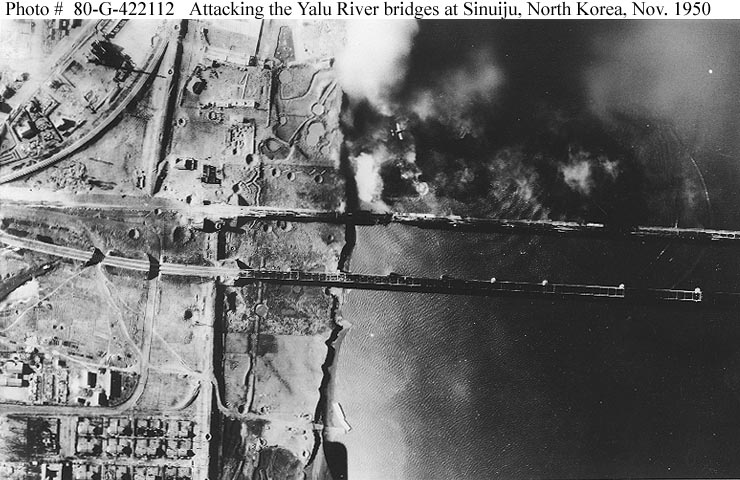
On the 10th the ship replenished at-sea and then, on the 11th and 12th, more strikes were by launched by VALLEY FORGE against the Yalu bridges. These encountered fierce opposition from both Yak and MiG aircraft as well as by flak. On the 13th a coordinated strike was made on Hyesenjin [sp?]. The ship replenished at-sea again on the 14th. Close air support was flown on the 15th, bad weather having diverted another strike on the Yalu river bridges. Weather was a problem throughout November. The ship replenished at-sea again on the 17th.
On 18 November one of the toughest fights of the month occurred when carrier aircraft had another go at the Yalu river bridges. Just as the F4U-4B Corsairs of VF-54 rendezvoused at 31,000 feet with F9F-2 and F9F-3 Panthers a few minutes prior to the attack, the strike group was jumped by no less than 12 MiGs. As the jets tangled it up in a wild melee, the Corsairs went after the anti-aircraft guns with 500-pound bombs, giving the AD-4 Skyraiders of VA-55 a chance to tackle the bridges. Unfortunately, hitting the dug-in guns was difficult, and intense flak riddled a couple of Skyraiders.
On the 19th, her deployment over, VALLEY FORGE detached to proceed to Yokosuka, Japan enroute to San Diego, where she arrived on 1 December 1950. In the period from 3 July to 19 November she had launched over 5,000 combat sorties which delivered 2,000 tons of bombs and rockets on their targets.
Aircraft losses for VA-55 in this first deployment were:
- 4 July 1950 Bureau Number 123804 hit by AAA over Pyongyan and crashed on the flight deck, pilot uninjured.
- 4 July 1950 Bureau Number 123814 damaged flying through debris, AAA damage near Pyongyang, pilot recovered uninjured.
- 22 July 1950 Bureau Number 123844 struck ground during low-level strafing run near Kangnyong-ni, pilot [Ensign Donald E. Stevens] killed in action. This is the same pilot from the previous incident.
- 25 July 1950 Bureau Number 123815 hit by its own bomb blast, pilot rescued, uninjured.
- 29 August 1950 Bureau Number 123845 hit by blast from own bomb while attacking bridge, pilot rescued.
- 22 October 1950 Bureau Number 124089 struck the barrier during a night landing, pilot uninjured.
- 25 October 1950 Bureau Number 123808 downed by small arms fire and ditched at sea. No data on the pilot.
Below, an AD-4Q Skyraider of VA-55 at NAS San Diego, California, in December 1950 following their return from deployment (Courtesy Robert Lawson Collection). Note that the VALLEY FORGE, scheduled for an overhaul period on her return, was instead turned around immediately and sent back to Korea with a new airwing. She would have a total of four deployments during that war, the most of any aircraft carrier.
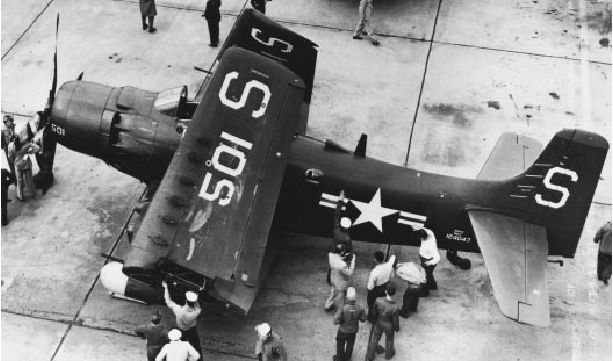
| Norman D. Hodson & the Capture of U-505
Norman was was born on 20 March 1920 in San Bernardino, California and died on 10 September 1988 in Iowa Park, Wichita, Texas. I think the following may refer to old 'Numbnutz.' From "CAPTURE OF NAZI SUBMARINE IN NINTEEN FORTY-FOUR REVEALED" of 16 May 1945, a Navy Department release : "One of the best kept secrets of the war was revealed today by announcement that on June 4, 1944, a U.S. Navy escort carrier task group reverted to the tactics of the early Continental Navy and hunted down, attacked, boarded, and captured the Nazi submarine U-505, 150 miles west of Cape Blanco in French West Africa. The Task Group then towed their prize 2,500 miles to Naval Operating Base, Bermuda. This was the first time the U.S. Navy had boarded and captured a foreign enemy man-of-war in battle on the high seas since 1815." This U-boat is now at Chicago Museum of Science & Industry. Fleet Composite Squadron 8 (VC-8) flew FM 'Wildcat' and TBM 'Avenger' aircraft. GUADALCANAL was an escort carrier (CVE). These small ships had notoriously lively flight decks. Their mission was anti-submarine warfare. |
For a full story of the squadron see The VA-55 Warhorses or Dictionary of American Naval Aviation Squadrons. Korean Combat Action Reports for the VALLEY FORGE can be found at the Navy Historical Center. A history of the Koran War, and many more photos, can be found at another Navy Historical Center page, "The Korean War."
Like many men involved in combat, my father-in-law is sometimes hesitant to talk about his experiences. This was war, not a video game, and people, even if they were combatants, were dying. The following may explain another aspect of this.
- In the summer of 1950 the U.S. Army in Korea was in full retreat. On 25 July, unable to stem the enemy tide, and panicing, they called in Air Force and Navy aircraft to strafe personnel on the ground they thought could be North Korean infiltrators. In this extremely fluid climate, attacks on civilians did occur. Strafing of civilians by aircraft of the USS VALLEY FORGE was reported in the after action report of 25 July 1950,
"Several groups of fifteen to twenty people dressed in white were sighted. The first group was strafed by one plane in accordance with information from the Army that groups of more than eight to ten people were to be considered troops, and were to be attacked. Since the first pass indicated that the people seemed to be civilians, other groups were investigated by non-firing runs. As they all seemed to be working in the fields, they were not attacked. An installation believed to be an ammunition storage or other military installation was strafed on one pass until it was determined to be a pottery factory. So many people came streaming out it lead to speculation that they may have been evacuated from their homes and had taken refuge. Most were women and children."
 In 1950, at the age of 22, Lloyd earned the Distinguished Flying Cross (DFC) while flying the AD-4 Skyraider in combat in North Korea. The Distinguished Flying Cross was established in the Air Corps Act, an Act of Congress dated 2 July 1926. It is awarded "to any person who, while serving in any capacity with the Armed Forces of the United States, distinguishes himself by heroism or extraordinary achievement while participating in aerial flight. The performance of the act of heroism must be evidenced by voluntary action above and beyond the call of duty. The extraordinary achievement must have resulted in an accomplishment so exceptional and outstanding as to clearly set the individual apart from his comrades or from other persons in similar circumstances. Awards will be made only to recognize single acts of heroism or extraordinary achievement and will not be made in recognition of sustained operational activities against an armed enemy."
In 1950, at the age of 22, Lloyd earned the Distinguished Flying Cross (DFC) while flying the AD-4 Skyraider in combat in North Korea. The Distinguished Flying Cross was established in the Air Corps Act, an Act of Congress dated 2 July 1926. It is awarded "to any person who, while serving in any capacity with the Armed Forces of the United States, distinguishes himself by heroism or extraordinary achievement while participating in aerial flight. The performance of the act of heroism must be evidenced by voluntary action above and beyond the call of duty. The extraordinary achievement must have resulted in an accomplishment so exceptional and outstanding as to clearly set the individual apart from his comrades or from other persons in similar circumstances. Awards will be made only to recognize single acts of heroism or extraordinary achievement and will not be made in recognition of sustained operational activities against an armed enemy."
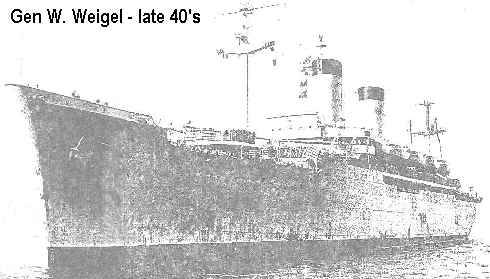 Lloyd married Virginia Rose Bassett Anderson in San Diego on 23 March 1951, soon after his return from Korea. In March 1951 Lloyd moved to 1108 1st street in Imperial Beach, California. He remained there until December 1953.
Lloyd married Virginia Rose Bassett Anderson in San Diego on 23 March 1951, soon after his return from Korea. In March 1951 Lloyd moved to 1108 1st street in Imperial Beach, California. He remained there until December 1953.
In January 1951 Lieutenant Commander Arthur L. Maltby Jr., an Academy graduate, had taken over the squadron and on 16 May 1951 all VA-55 personnel, except 16 officers and 5 enlisted men, were embarked on USNS GENERAL WILLIAM WEIGEL (TAP 119), a troop ship, and sent to Japan for duty with Air Group 19 (CVG-19) aboard USS PRINCETON, CV 37, which was part of Carrier Division Five, Task Force 77. The remainder of VA-55's personnel were airlifted to Japan on 17 May. Before they left San Diego all the pilots renewed their carrier quals onboard USS ESSEX (CV-9).
The squadron was initially assigned to Air Group 19X, an air group based in Japan that replaced squadrons in Air Group 19 operating in Korean waters. Their tail letter switched from S to, first X, and eventually became B in the new airwing. On 29 May 1951 VA-55 embarked on PRINCETON, replacing VA-195 in Air Group 19 (CVG-19), and proceeded to Korea for combat operations. The squadron took over and flew the aircraft of VA-195.
| Arthur Lauren Maltby, Jr.
He was born on 27 July 1918 and was an Annapolis graduate, class of 1940. He reported aboard the MINNEAPOLIS (CA 36) on 2 July 1940 and was assigned to be the Assistant Navigator. He detached from MINNEAPOLIS in September 1942. In October he was promoted to Lieutenant and and began flight training. He earned his wings at NAS May 1943 and was ordered to NAS Jacksonville for further operational training. After qualifying at NAS Glenview on the small carrier SABLE, he spent the rest of the year at NAS Vero Beach as an Assistant Instructor. He was ordered to VB-85 when it was commissioned on 15 May 1944 and took command in January 1945. Embarked in USS SHANGRI-LA, VB-85 began its combat operations on 25 April 1945. They flew the Curtiss SB2C-4 Helldiver. After World War II he was the Navigator on USS PALAU. In July 1947 he reported to the Service Test Division of the Naval Air Test Center. In 1951 Art took command of VA-55, which became part of Air Group 19 when it got aboard PRINCETON. Art was Acting Air Group 19 Commander for the last two months of the cruise. He won two Navy Crosses, two DFC's, three Air Medals, and a Purple Heart. He retired on a disability in 1965. Fully retired since 1973 as a Commander. He has Multiple Sclerosis. |
| USS PRINCETON
The fifth ship of this name, USS PRINCETON (CV 37), was launched on 8 July 1945. She was decommissioned on 20 June 1948 and joined other capital ships in the Pacific Reserve Fleet. She was recommissioned in August 1950 with a largely Naval Reserve crew and began the first of three Korean War combat tours late in the year. She operated with Task Force 77 in support of United Nations forces in Korea from December 1950 to August 1951, from April to October 1952 and from March 1953 to the end of the conflict that summer. |
In late May, the squadron flew against the railroad bridges connecting Pyongyang with Sunchon, Sinanju, Kachon, and the transpeninsula line. Next, they combined close air support with raids on power sources in the Hwachon Reservoir area and, with the stabilization of the front there, resumed interdiction. For much of the summer they pounded supply arteries, concentrating on highways. During this period of the war the supply situation had been worked out. Supply ships, both for refueling and ammunition, were available and the mail service was regular. Aircraft losses for VA-55 during this second deployment were:
- 6 June 1951 Bureau Number 123931, engine failure while providing CAP, pilot bailed out, rescued.
- 21 June 1951 Bureau Number 123932, landing accident
- 25 June 1951 Bureau Number Unknown, hit by AAA, crashed at K-18 airfield, pilot uninjured.
- 28 June 1951 Bureau Number 123855, hit by small arms fire while strafing, struck ground and burned, pilot KIA.
- 27 July 1951 Bureau Number Unknown, loss of oil pressure, ditched at sea near Kosang.
In August USS PRINCETON detached and returned to San Diego on 21 August 1951.
Lloyd's first daughter, Annie, was born in November 1951.
In January 1952 Lloyd left the squadron, now with almost 1000 hours of flight time, but he still needed a few more months to fulfill his requirement for sea-duty time before transferring to a shore command. I'm guessing the requirement must have been 3 years. He reported to San Diego in October 1949 and left in November 1952.
Lloyd wrangled a set of orders to FASRON 691, a Fleet Aircraft Service Squadron. They provided depot-level maintenance to a variety of aircraft, so there were always a number of aircraft that need post-maintenance check flights, as well as ferry flights to their new commands. Lloyd got a wide experience during this short set of orders, flying all variants of the AD 'Skyraider," the SNB 'Navigator,' a Navy trainer based on the old Twin Beech, the AF-2W & AF-2S 'Guardian,' a Grumman aircraft built in attack, early warning & anti-submarine variants, the TBM 'Avenger' torpedo bomber, the JRB 'Expeditor,' a transport version of the twin Beech, and the F4U 'Corsair.' I think he transferred out of the command in November 1952. His logbook is at times maddenly unclear.
| The Grumman Guardian
The "Guardian" was a large aircraft, standing over 16 feet tall and weighing over 25,000 pounds. |
 He
Lloyd then got orders to go back to the training command as an instructor. He was at NAS Corpus Christi, Texas, flying the AD-1, and later the AD-2 and AD-4 variants of the 'Skyraider,' with Advanced Training Unit 301 (ATU-301). They were the AD advanced training squadron, redesignated Training Squadron 30 (VT-30) in the 1960's. One source I found indicates this squadron was based at NAAS Cabanniss Field. This was an outlying field some 8 miles from the main base at Corpus Christi. Lloyd's logbook makes several references to CRP, which today is the designator of the civilian airport in town, but it also appears to be a shorthand for the town. In April 1954 his logbook shows that he put on an Airshow. I assume that unlike his trips home to Bishop, this was a sanctioned event. By November 1954 he had over 2000 flight hours. He successfully trained 24 Naval Aviators, all of whom successfuly received their wings as carrier pilots.
He
Lloyd then got orders to go back to the training command as an instructor. He was at NAS Corpus Christi, Texas, flying the AD-1, and later the AD-2 and AD-4 variants of the 'Skyraider,' with Advanced Training Unit 301 (ATU-301). They were the AD advanced training squadron, redesignated Training Squadron 30 (VT-30) in the 1960's. One source I found indicates this squadron was based at NAAS Cabanniss Field. This was an outlying field some 8 miles from the main base at Corpus Christi. Lloyd's logbook makes several references to CRP, which today is the designator of the civilian airport in town, but it also appears to be a shorthand for the town. In April 1954 his logbook shows that he put on an Airshow. I assume that unlike his trips home to Bishop, this was a sanctioned event. By November 1954 he had over 2000 flight hours. He successfully trained 24 Naval Aviators, all of whom successfuly received their wings as carrier pilots.
During his time in Corpus, from December 1953 to June 1955, Lloyd lived at 1814 Keys street.
Around this time the Assistant Secretary of the Navy for Air decided he wanted to become a Naval Aviator. For advanced training he pulled Lloyd as his instructor. He did well and at the end of his training asked Lloyd what he could do for him. Lloyd asked for a transition to jets. At that time the only way to get jets was to have jet experience, or come up 'green' through the training command. With the intercession of the Secretary Lloyd got orders to a Jet Transition Training Unit (JTTU).
| The Assistant Secretary of the Navy for Air
This was probably John F. Floberg who served as Secretary for Air from 5 December 1949 to 23 July 1953. He was born in 1915. A lawyer, after serving as Assistant Secrety he was one of six members of the Atomic Energy Commission from 1957 to 1960. In 1960 he became general counsel for the Firestone Tire and Rubber Company, later rising to be vice president and then director and member of its executive committee. From "A History of the USS CABOT (CVL-28): A Fast Carrier in World War II" by J. Ed Hudson, "Secretary of The Navy For Air John F. Floberg lands on board the Cabot in a SNJ-5C on 18 April 1955." This must have been his carrier qual in basic flight training. |
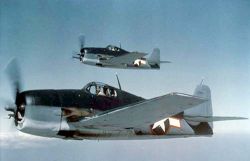 From 11 March to 18 May 1955 Lloyd was on detached duty at Naval Air Station Memphis, Tennessee and picked up about 12 hours in the F6F-5 'Hellcat,' a World War II fighter. I'd guess Lloyd was in Memphis to learn the basics about Jet aircraft. Naval Air Training Center Memphis is still the location of the Navy's 'A' schools, where aviation enlisted men go to learn how to repair aircraft. Here Lloyd would learn about the advanced systems in jet aircraft, including engines, fuel systems, hydraulics and pneumatic back-ups.
From 11 March to 18 May 1955 Lloyd was on detached duty at Naval Air Station Memphis, Tennessee and picked up about 12 hours in the F6F-5 'Hellcat,' a World War II fighter. I'd guess Lloyd was in Memphis to learn the basics about Jet aircraft. Naval Air Training Center Memphis is still the location of the Navy's 'A' schools, where aviation enlisted men go to learn how to repair aircraft. Here Lloyd would learn about the advanced systems in jet aircraft, including engines, fuel systems, hydraulics and pneumatic back-ups.
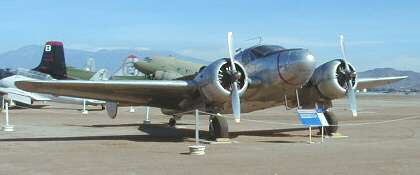 From 31 May to 1 June Lloyd got three flights in an SNB-5, the transport version of the twin Beech, totaling about 10 hours. Though he took first pilot time, I'm thinking this was Lloyd's flight from Memphis to the next stage of his Jet training, the transition squadron itself.
From 31 May to 1 June Lloyd got three flights in an SNB-5, the transport version of the twin Beech, totaling about 10 hours. Though he took first pilot time, I'm thinking this was Lloyd's flight from Memphis to the next stage of his Jet training, the transition squadron itself.
In June 1955 he began flying the TV-2 and F9F-6 'Cougar.' This was at the JTTU at NAS Olathe in Gardner, Kansas. Astronaut John Glenn got his initial training at this base. Lloyd spent only a month there, finishing on 23 June 1955, getting a jet familiarization course and nothing more.
| The JTTU's
After only two months, the unit transferred to NAS Whiting Field, Milton, Florida, and was redesignated Jet Transitional Training Unit ONE (JTTU-1). The squadron's mission was extended to include training of fleet pilots. On 20 August 1951, JTTU-1 moved to its present location at NAS Kingsville, Texas and was redesignated Advanced Training Unit 3 (ATU-3). Late in 1952, ATU-3 became ATU-200. The squadron's mission consisted of training newly designated aviators in familiarization, formation tactics, instruments and navigation. ATU-200 was redesignated ATU-212, and with the new name, came the mission of all-weather flight training. There was also a JTTU at NAS Olathe, in Gardner, Kansas. It was established on 4 April 1955 to provide student training for aviators transferring from shore to sea duty in the rank of commander and below. In addition to providing refresher training for these "desk pilots," the unit was responsible for training pilots making the transition from prop to jet type aircraft. Edward L. "Whitey" Feightner was the skipper. A "JTTU" also referred to an already winged aviator going through the Strike Syllabus as a student. |
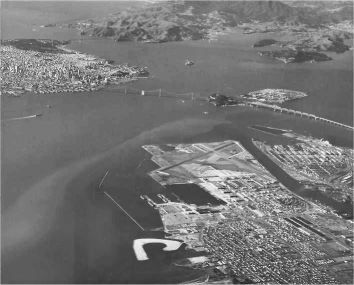 Lloyd's logbooks, which are silent for much of July (transit time to the west coast?) begin to mention Naval Air Station Alameda on 27 July 1955 with flights in the F9F-6. Alameda is located on the eastern side of San Francisco bay, near the city of Oakland. The airfield is north of the carrier piers in the photo at left.
Lloyd's logbooks, which are silent for much of July (transit time to the west coast?) begin to mention Naval Air Station Alameda on 27 July 1955 with flights in the F9F-6. Alameda is located on the eastern side of San Francisco bay, near the city of Oakland. The airfield is north of the carrier piers in the photo at left.
Lloyd and his family lived at 306A Pacific avenue, Alameda, California.
Lloyd's logs were signed by a Lieutenants Grosshuesch and Sheil of the VF-24 Operations department and I assume he was assigned to that squadron. They had just returned from deployment in June and would begin to transition from the F9F-6 'Cougar' to the FJ-3 'Fury.' Note: On 1 September 1955 in the race for the North American Trophy, an event of the National Air Show, four FJ-3 'Furies' of VF-24 launched from the USS SHANGRI-LA at sea off the Pacific coast of Mexico and flew non-stop 1,198 miles to Oklahoma City without refueling. The winner was Lieutenant Junior Grade Grosshuesch, with a time of 2 hours 13 minutes 38.6 seonds for an average speed of 537.848 mph. During this exciting period Lloyd was completing the Jet syllabus, a course in instrument flying, at the Fleet All Weather Training Unit Pacific (FAWTUPAC). There he again flew the TV-2. He completed the course on 2 September 1955.
| VF-24
The squadron deployed to the Western Pacific with Air Wing 2 (CVG-2) onboard USS YORKTOWN (CVA-10) from 3 August 1953 to 3 March 1954. They were flying the F9F-6. They deployed with CVG-2 onboard USS ESSEX (CVA-9) from 3 November 1954 to 21 June 1955 flying the F9F-? [probably the -6]. They again deployed to the Western Pacific with Carrier Air Wing 2 (CVG-2), this time onboard USS SHANGRI-LA (CV-38) from 13 November 1956 to 20 May 1957. Squadrons in the Air Wing included VF-24 (FJ-3), VA-63 (F9F-8), VF-64 (F2H-3), VA-65 (AD-6), VAH-6 (AJ-2) VFP-61 (F9F-8P), AV(AW)-35 (AD-5N), VAW-11 (AD-5W), VX-4 (F7U-3M), and HU-1. After Lloyd's tour they deployed from 16 August 1958 to 12 March 1959 on USS MIDWAY (CVA-41), flying the F-3H 'Demon.' Leroy F. Snider: "I was an AO-3 in VF-24 in 1957 - 58. We flew the FJ3-M. We were a part of CAG-2 out of NAS Alameda and made a Far East tour the winter of 57/58 on CVA-38, USS Shangri La. This differs with the history I have found on the WEB." [?] |
In October and November 1955 Lloyd attended training at the Fleet Air Gunnery Unit (FAGU), flying the F9F-8 'Cougar.' This was a squadron and school, established in May 1952, under the Commander Air Force, Pacific Fleet, and located at Naval Auxilary Air Station (NAAS) El Centro in the Imperial Valley of California. They trained prospective Weapons Training Officers (WTO) in the latest weapons delivery tactics, especially air-to-air gunnery. These WTO's would then return to their squadrons and impart what they learned at FAGU to their squadron-mates. FAGU also hosted the annual Naval Air Weapons Meet. In the 1970's, as a result of poor results during the Vietnam War, the Navy created a school where fighter pilots could get a post-graduate education in air-to-air combat, adapting the Fleet Air Gunnery Unit into what ultimately became known as TOPGUN.
Lloyd reported that the F9F-8, which had a larger wing area than the -6 through the addition of a wing root fillet, was a much more stable aircraft and did not demonstrate the "dutch-roll" characteristics on final approach that had dogged the earlier aircraft.
Then, beginning in December 1955 Lloyd began to fly the FJ-3 'Fury,' apparently one of the last VF-24 pilots to make the transition. The 'Fury' was the Navy version of the Air Force F-86E.
| FJ-3 'Fury'
The FJ-3M carried the Sidewinder Air-to-Air missle. The FJ-4 had a thinner wing and 50 per cent more internal fuel in a revised fuselage. The FJ-48s had six hardpoints and nuclear capability. 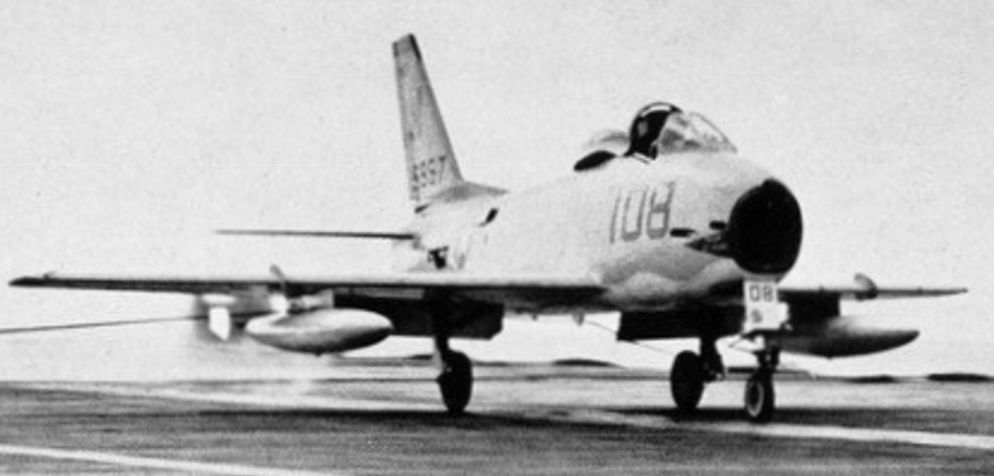 VF-24 FJ-3M takes a trap onboard SHANGRI-LA |
The last stage of training for the squadron before deployment was at Naval Air Station Fallon, Nevada, a remote field in the open stretches of desert east of Carson City. There the Air Wing could practice bombing, strafing, air combat, joint tactics, and massed air attacks with little fear of disturbing the local populace.
The FJ was one of Lloyd's favorite aircraft. It had a more powerful engine than the USAF F-86's of the day and when the Navy and Air Force tangled, as they often did off the southern California coast, it was satisfying to have the extra power and consequent turning performance. The Air Force complained at one point because their aircraft, which were interceptors tasked with enforcing the Air Defense Interdiction Zone (ADIZ), which the Navy routinely violated, were so aggresively resisted. The Navy fighter pilots, of course, howled at this lame complaint.
In July 1956 Lloyd flew again with the FAWTUPAC, completing the "B" Jet refresher instrument syllabus and flight check on 26 July 1956.
Field Carrier Landing Practice (FCLP) began in earnest at Alameda in August and Lloyd began carrier qualifications in September 1956. In that month he carrier qualed in the FJ-3 on USS SHANGRI-LA (CV-38). He 'hit' the same boat again in October and November, making short cruises off the Southern California coast, near NAS Miramar, getting 21 more before deploying with her on 13 November 1956 for a WESTPAC tour.
In 1956 and 1957 Lt. Lloyd L. Montague was listed as a resident of 328A Pacific Avenue, Alameda, California in the City Directory.
| USS SHANGRI-LA (CV-38)
USS SHANGRI-LA was one of the ESSEX class aircraft carriers and the first ship to bear the name. The name "SHANGRI-LA" was taken from a speech of President Roosevelt regarding the Doolittle Raid, the first American air strike against the Japanese homeland, in 1942. In his speech, President Roosevelt referred to the origin of the Tokyo raid only as "SHANGRI-LA." She was laid down by the Norfolk Navy Yard, at Portsmouth, Va., on 15 January 1943, launched on 24 February 1944, sponsored by Mrs. James H. Doolittle, and commissioned on 15 September 1944. She was recommissioned on 10 January 1955 following an extensive overhaul in which she received an angled flight deck, twin steam catapults, and her aircraft elevators and arresting gear were overhauled. At a cost of approximately $7 million, she was virtually a new ship. She conducted intensive fleet training for the remainder of 1955, then deployed to the Far East from 5 January 1956 to 23 June 1956. She again deployed to the Western Pacific with Carrier Air Wing 2 (CVG-2) from 13 November 1956 to 20 May 1957. Until 1960 she alternated western Pacific cruises with operations out of San Diego. In 1960 she transferred to the Atlantic fleet and was home-ported out of Mayport, Florida. 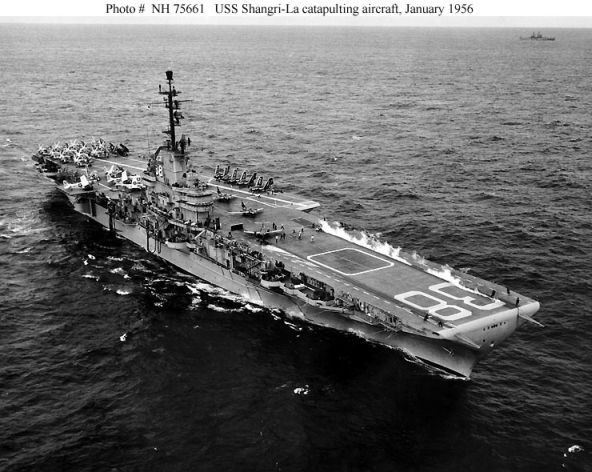 |
VF-24 was divided into 6 flights of four pilots each. Lloyd was the leader of the junior flight, nicknamed Wildcat. They joined the SHANGRA-LA in November 1956. Their commanding officer was CDR W.L. Adams and the Exec was LCDR J.E. Sheil.
The squadrons of Carrier Airwing Two on the "Shang":
- VF-64 "Freelancers", Night Fighter-Special Weapons [nukes], F2H-3 Banshee - Note, I was a member of the "Freelancers," then numbered VF-21, in the mid-1980's, flying in the F-4N and F-14A
- VA-65 "Tigers", Attack, AD-6
- VA-63 "Red Cocks", Attack, F9F-8 Cougar
- VF-24 "Corsairs", Day Fighter-Interceptor, FJ-3 Fury
- VX-4, Interceptor, F7U-3M Cutlass [this was a utilization experiment, in part to determine if more of the controversial aircraft should be procured. Known as the Ensign Killer.]
- VAH-6 "Fleurs", Heavy Attack-Special Weapons [nukes], AJ-2 Savage
- VAAW-35 "Night Hecklers", All Weather Attack, AD-5N [it had a back-seater who operated the radar bombing system]
- VAW-11, Airborne Early Warning, AD-5W "Guppy"
- VFP-61, Photo Recon, F9F-8P Cougar
- HU-1, rescue, HO3S-1
Lost at Sea, 23 December 1956, LTJG James P. Butler, VF-24. He was Lloyd's wingman. On that day they launched together, one on the left catapult, the other on the right. Everything seemed normal after launch, but then Butler drove into the water. No explanation for the accident was ever found.
Killed, 27 February 1957, CDR Denmark, VF-24. He was the squadron's executiver officer [no. 2 man], but when the squadron deployed he had to stay behind due to an illness. Afterwards, trying too hard to catch up, he spun in during field carrier landing practice.
- from "Saga of a Lady, the cruise of the USS SHANGRA-LA (CVA-38) and Carrier Air Group Two, November 1956-May 1957."
During an uneventful deployment the ship stopped at all the 'usual' ports of call; Hawaii; Yokosuka, Japan; Subic Bay, the Philippines; Hong Kong. The stay at Naval Base Subic Bay was an extended one. For two weeks in January 1957 and another two weeks in February. Subic was a major American base and repair depot for the fleet. While in port the squadron operated out of the airfield at Naval Air Station Cubi Point. The field was located next to the carrier piers. The Cubi Officers' Club was located on a hill, high above the bay, and afforded tremendous views both of the airfield and naval shipping. The town outside the front gate was called Olangapo and it was just as rough, and tawdry, a place as any border town. This is the foreign town represented in the "sepia-toned" portions of the film "An Officer and a Gentleman."
Lloyd's last flights with the squadron were recorded in April 1957, a month before the cruise ended and after less than two years in the Air Wing. It is not clear why this was so. The Air Wing may not have flown the last month of the cruise, from Hawaii to California. This is still sometimes done to save fuel. They would have then craned-off the aircraft in Alameda. Whatever the reason, by June Lloyd was no longer in the squadron.
It was at this time that Lloyd took a sabatical in order to finish his undergraduate degree at the University of Southern California. Due to limitations in time and the number of years since he had last studied Engineering, he was unable to finish the Mechanical Engineering degree he had originally started in 1945. He chose instead to pursue a degree in Criminal Justice, attending USC from June 1957 to June 1959. Anita, his second daughter, was born in Los Angeles on 31 January 1958 while her father was going to school at USC. The family lived at 8144 Elizabeth avenue, South Gate, California.
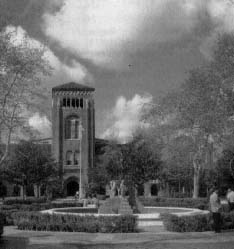 The University of Southern California
Located in what is known as 'down town' Los Angeles, the University opened its doors in 1880 with 53 students and 10 teachers. Today it is home to over 28,800 students and 3,800 faculty and its neighborhood is better known as Watts. A private schook, it is also known as the University of Spoiled Children. The University of Southern California
Located in what is known as 'down town' Los Angeles, the University opened its doors in 1880 with 53 students and 10 teachers. Today it is home to over 28,800 students and 3,800 faculty and its neighborhood is better known as Watts. A private schook, it is also known as the University of Spoiled Children.
|
To keep up his flight currency, Lloyd flew the SNB-5 out of Naval Air Station Los Alamitos, which is located south of the USC campus near Long Beach. His first flight was in June 1957. He flew as little as 2.2 and as much as 22 hours a month, quite often in multi-day, 'round-robin' flights, until 19 June 1959, making this almost exactly a two-year sabbatical.
| NAS Los Alamitos
The history of Los Alamitos began with the commissioning of a Naval Reserve Air Base (NRAB) on 10 May 1928 at Long Beach Municipal Airport. Its mission was to instruct, train and drill Naval Reserve aviation personnel living in the Eleventh Naval District. In the 1970's the base was changed into an Armed Forces Reserve Center operated by the California Army National Guard. Today Los Alamitos Army Airfield is one of the most active DOD aviation operations in the Continental United States. It is located in Orange county, just north of the Seal Beach Naval Weapons Stations. |
In July [March?] 1959 Lieutenant L.L. Lloyd was assigned to the staff of the Commander, Carrier Division Five, as Flag Lieutenant for, first, Admiral Davis Welch, and, after a change-of-command on 25 January 1960, for Rear Admiral Alexander Heyward Jr., onboard USS MIDWAY, stationed in NAS Alameda. The Flag Lieutenant is an aide-de-camp (ADC) of the Admiral, junior to the Admiral's Aide. In this job Lloyd would have worn an aiguillette, a gold rope over his uniform sleeve, to denote his status. The Navy knows these as "loafer's loops." This was a good set of orders. If the Admiral liked you he could be very helpful to you in the future.
| The Admiral's Aides
The Flag Lieutenant originally got his name from his duty in charge of passing the Admirals orders, via signal flags, to the rest of the fleet. From the Navy's official guide to billet descriptions:
The Flag Lieutenant was nicknamed "Flags" and sometimes referred to as "Dog Robber." The latter is a derivation of earlier slang for the servant of a member of the military, a Knight or a noble, whose job it was to provide in every way for his Master. Such servants would go so far as to steal the food from a dog's bowl to feed their master if necessary. Obviously not a term of endearment. There was a movie released in 1937 called "The Flag Lieutenant." |
Lloyd and his family lived 1180 Hilltop drive, Chula Vista, California.
The MIDWAY deployed to WESTPAC soon after Lloyd arrived, on 15 August 1959. The ship left from Alameda, California and made port visits in Pearl Harbor, Guam, Subic Bay, the Philippines, Buckner Bay, Okinawa, Yokosuka, Japan, Kobe, Japan, Sasebo, Japan, Hong Kong, before returning to Alameda on March 1960
| USS MIDWAY (CVB/CVA/CV-41)
CVB-41, the lead ship of the Midway class, was ordered on 7 August 1942. She was named after the carrier battle of Midway Island in June 1942 which turned the tide of World War II in the Pacific and proved conclusively the potential of naval aviation. CVB-41 was the third American ship and the second aircraft carrier to bear the name of Midway. The name of the first USS Midway, a fleet auxiliary, was changed to the USS Tanay in April, 1943. The second ship bearing the name was a jeep carrier USS Midway, CVE-63, which was changed to the USS Saint Lo in September 1944. MIDWAY was the largest warship in the world for the first decade of her service and was referred to as a Battle Carrier (CVB) to denote her huge size. She was originally an Atlantic Fleet carrier. After many years of service there, in December 1954, with Air Group One aboard, Midway departed Norfolk on a world cruise, which culminated in her transfer to the Pacific Fleet. She arrived in her new home port, NAS Alameda, California, in July 1955. Sometime prior to this she had been renamed an Attack Carrier (CVA). The other type of aircraft carrier current at the time was the Anti-Submarine Warfare Carrier (CVS). MIDWAY entered Puget Sound Naval Shipyard, Washington and was decommissioned for the first time in October 1955. MIDWAY underwent a modernization project to give her the capability to operate high performance jet aircraft. She was fitted with an angled flight deck, two steam catapults on the bow and a shorter steam catapult in the new angle deck. The purpose of the third catapult was to allow ready deck launches while keeping the landing area clear for recoveries in an "alert" situation. Additional improvements included the installation of a hurricane (enclosed) bow, moving elevator number three to the starboard deck edge aft of the island, enlarging the number one elevator to accommodate longer aircraft, new arresting gear, jet blast deflectors, and the largest aviation crane ever installed on an aircraft carrier. On recommissioning in September 1957, Midway's load displacement had grown from 55,000 to 62,000 tons. 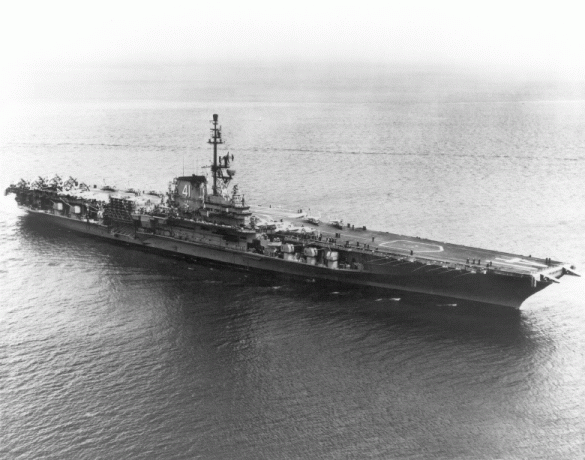 In August 1958, MIDWAY was underway on her first deployment as an angle deck carrier. With MIDWAY's increased combat capabilities, Carrier Air Group Two (CVG-2) was composed of two supersonic fighter squadrons and three attack squadrons. During this cruise, she operated off Taiwan in support of the Quemoy-Matsu crisis as the flagship of COMCARDIV Five. She returned to Alameda in March of 1959. In August 1959, after a one-month turn around period, Midway redeployed to the Far East. During this cruise, she recorded 8,000 landings, including her 80,000th arrested landing. Her eleventh deployment ended with arrival at Alameda in March 1960. |
According to a COMCARDIV 5 Staff Air Operations memorandum to the Operations Officer of NAS Alameda, LT Montague was qualified to fly the F9F-8, FJ-3 and SNB. In the tail-end of July and in August 1959 Lloyd got a couple of flights in the TV-2, two in the TF-1 'Trader, perhaps under instruction, and another time-builder flight in the SNB. The TF-1 was a transport variant of a twin-radial engined, carrier aircraft built by Grumman. It saw duty in the anti-submarine warface & airborne early warning missions, and as a Carrier Onboard Delivery (COD) aircraft. From personal experience, a deck-launch in the C-1, as the COD was known, could be heart-stopping.
MIDWAY's airwing was CVG-2, comprised of VF-24, flying the F8U-1 'Crusader,' VF-21, flying the F3H-2 'Demon,' VA-22 and VA-23, in the FJ-4B 'Fury,' VA-25, in the AD-6 'Skyraider,' VAH-8, in the A3D-2 'Skywarrior,' VFP-61A, in the F8U-1P, VAW-11 Det A, in the WF-2 'Tracker' or, as the fleet knew it, the 'Willy Fudd,' and HU-1 Det A, in the HUP-2 helicopter.
Lloyd was not qualified to fly any of these Air Wing aircraft. During the cruise, in logbook entries from September 1959 to January 1960, Lloyd got flights at shore stations around the Pacific. He flew various SNB's at Barbers Point, Hawaii, Cubi Point, the Philippines, Atsugi, Japan and Naha, Okinawa. Lloyd indicated that most of these flights were with the Admiral, since he needed to keep up his flight time too. The MIDWAY returned home on 25 March 1960. Lloyd may have flown-off early, possibly leaving the ship in Hawaii, in order to make his next set of orders.
With the cruise over, and the Admiral off to other assignments, in February 1960 Lloyd started a course of study at the Navy Post Graduate School (NPGS) in Monterey, California [which course I wonder?]. He was at the school until January 1961. From March through December 1960 he flew the JRB-6 and SNB-5 out of Navy Auxilary Landing Field (NALF) Monterey. Lloyd and his family lived at 40 Upper Circle, Robles del Rio in Carmel Valley, California.
Lloyd was then assigned to the Bureau of Weapons (BuWeps) in the Pentagon from January 1961 to February 1963. Originally two separate commands, the Bureau of Aeronautics and the Bureau of Ordnance, in 1959 they were combined to create a single organization in charge of the development of all new naval weapons and aircraft systems. Based on his background, Lloyd probably had a career as an air-to-surface ordnance development officer. The family lived at 5222 Dalton road, Springfield, Virginia at this time.
The rules of the era required pilots to log at least 100 hours of flight time a year to keep drawing flight pay, so Lloyd grabbed flights in the SNB and T-28 at Navy Auxilary Landing Field (NALF) Andrews, the Navy-side of Andrews Air Force Base, the home of Air Force 1.
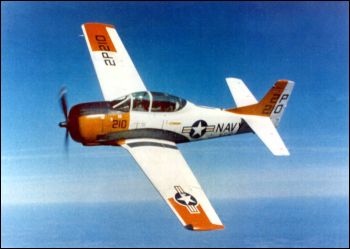 While on such a flight on 3 May 1962 he had a bad crash at Andrews AFB in a T-28B, BUNO 137735, in which his copilot/passenger was killed, possibly in a gruesome fashion. It was a long flight, 7.2 hours, with the last 1.5 hours at night, which may have contributed to the accident. Lloyd was transferred to the Hospital, Andrews Air Force Base with 1st and 2nd degree burns, face and left forearm.
While on such a flight on 3 May 1962 he had a bad crash at Andrews AFB in a T-28B, BUNO 137735, in which his copilot/passenger was killed, possibly in a gruesome fashion. It was a long flight, 7.2 hours, with the last 1.5 hours at night, which may have contributed to the accident. Lloyd was transferred to the Hospital, Andrews Air Force Base with 1st and 2nd degree burns, face and left forearm.
". . . patient states he was piloting a T-28 aircraft and during the approach the engine quit and the aircraft hit an embankment along Route #4."
Lloyd continued to fly until 7 February 1963, then gave up flying forever. He got 3168.8 hours total flight hours during his flying career.
Lloyd was redesignated a 1350, which in Naval parlance denotes a ground-pounding aviator, or aviation maintenance officer. A Navy pilot is a 1310, while a naval flight officer, a 'backseater' like myself, is a 1320. Sure that his career was over, and disillusioned with aviation, he requested to transfer into the Intelligence community. To his surprise, he was accepted. I think intelligence is a 1630 designator.
From March to June 1963 Lloyd and his family lived at 1226 12th avenue, Hanford, California while he attended the Fleet Air Intelligence Training Center for transition training. He was then designated as an Aviation Intelligence Officer.
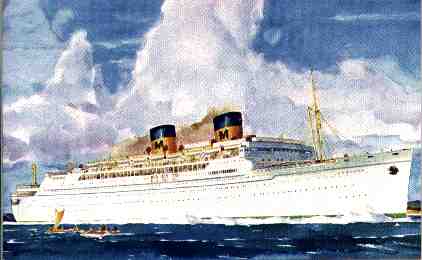 Lloyd served as Air Intelligence Officer on the USS ORISKANY (CVA-34) from July 1963 to June 1965, before things in Vietnam really heated up. Carrier Air Wing 16 was embarked. The 'O-boat' was designated flagship of Carrier Division Nine. Lloyd complained that there was no real 'intelligence' gathered in the Vietnam War. One of Anita's favorite stories about her father's life is a visit she made as a young girl to her father's stateroom on the ORISKANY. She noted the phone on his desk and wondered why he never called home during the ship's deployment? It was, of course, in those pre-satellite phone days, an on-ship phone only.
Lloyd served as Air Intelligence Officer on the USS ORISKANY (CVA-34) from July 1963 to June 1965, before things in Vietnam really heated up. Carrier Air Wing 16 was embarked. The 'O-boat' was designated flagship of Carrier Division Nine. Lloyd complained that there was no real 'intelligence' gathered in the Vietnam War. One of Anita's favorite stories about her father's life is a visit she made as a young girl to her father's stateroom on the ORISKANY. She noted the phone on his desk and wondered why he never called home during the ship's deployment? It was, of course, in those pre-satellite phone days, an on-ship phone only.
From July 1963 to July 1965 Lloyd and his family lived at 1840 Jason street, Chula Vista, California.
| USS ORISKANY
She was a 27,100 ton Ticonderoga class aircraft carrier known to her crew as the 'O-Boat.' She was launched on 13 October 1945, however World War II was over and she was laid up in an incomplete status. ORISKANY wasn't completed until the Korean War was in progress. In November 1951 she was again placed in an inactive status for a flight deck renovation, which was completed in May 1952. In the aftermath of the Korea war she made one more cruise to the Far East at the end of 1953. It was after this that the movie, "The Bridges of Toko Ri," was filmed onboard her. After two more deployments to the Western Pacific she returned to San Francisco and entered the shipyard for overhaul on 1 October 1956. She decommissioned there on 2 January 1957 for modernization. She was out of commission from January 1957 until March 1959, during which time she was modernized with a new angled flight deck, steam catapults, an enclosed "hurricane" bow and many other improvements that permitted safer operation of high-performance aircraft. Oriskany's second war began with her 1965 WestPac cruise, during which her planes hit targets in North and South Vietnam. She returned to San Diego 16 December 1965. She again deployed to southeast Asia on 26 May 1966. Tragedy struck the carrier on 26 October 1966, off the South Vietnam coast, when a magnesium parachute flare exploded in the forward flare locker of Hanger Bay 1, beneath the carrier's flight deck. The fire ravaged her forward compartments, killing 44 members of her crew and air group. San Francisco Bay Naval Shipyard completed repairs on 23 March 1967 and ORISKANY, with Carrier Air Wing 16 embarked, stood out of San Francisco Bay on 16 June to take station in waters off Vietnam. She was designated flagship of Carrier Division Nine. She returned to NAS Alameda on 31 January 1968 and entered San Francisco Bay Naval Shipyard 7 days later for an eight month overhaul. |
"After Vietnam service he served as Senior Evaluator of Operational Planning and Intelligence during the operational readiness inspections of all Pacific Fleet Carriers deploying to the Vietnam Warfrom 1965 to 1968." He was on the staff of the Commander Fleet Air Hawaii (COMFAIR) at Barbers Point. His duties were as Senior intellignece inspector for attack carrier operational readiness inspections (ORIs). The latter is the final inspection before a carrier and airwing are qualified to go on deployment . . . it's a big deal.
The family went to Hawaii on the SS LURLINE, a commercial passenger ship of the Matson Line. She plied the San Francisco-Los Angeles-Honolulu route. Lloyd and his family must have been on one of her very last cruises. According the Gordon Prange's "At Dawn We Slept," in 1941 the LURLINE's radio operators picked up radio traffic of the Japanese task force enroute to the attack on Pearl Harbor. This was reported to the FBI, but nothing was done.
Lloyd made a name for himself in the SIOP, or Single Integrated Operational Plan, world. This was the military's attempt to integrate the strategic nuclear plans of the US Army, Air Force and Navy. Lloyd found that while squadrons and ships were well trained and well prepared on an indiviudal mission level, they had little idea of the bigger picture. He changed that and made this part of the battle group's operational readiness exams. Lloyd liked to say that it was this that made him a Captain.
Anita remembers living for a time in the Ilikai hotel on Waikiki beach. She said that during this time the movie "Hawaii" was being filmed and its star, Julie Andrews, was living on the top floor of the hotel. Anita remembers walking with her mother past the hotel's glass elevator, stepping inside, and pushing the button that took it to the top floor. She stepped out at the top and remembers a very nice lady meeting her and getting her back down to her mother. She is sure this was Julie Andrews. However, I don't think Ms. Andrews was staying at the Ilikai, but rather in a rented cottage near Diamond Head. The movie was filmed in 1965.
Lloyd's family lived in base housing on the western side of Oahu, not far from the Naval Magazine at Lualualei, at 5193 Iroquois avenue, Ewa Beach from July 1965 to August 1968. Their home was on the beach with a long view of Diamond Head. Lloyd's duties frequently took him to Kaho'olawe island, a Navy bombing range at that time, now a "sacred" site for the Hawaiians. He spent much of his time on the island shooting goats. These had been introduced to the island as a source of meat and were devastating the natural habitat.
In September 1968 Lloyd was back in California, living at 1136 Vista Way, Chula Vista. He was working at the Nuclear Weapons Training Center, Pacific as Course Supervisor from August 1968 to June 1970. His duties included training senior attack carrier officers in general war operations.
From June 1970 to February 1971 he was the Chief of the Weapons Division at the Navy Scientific and Technical Intelligence Center. There he performed intelligence analysis dealing with foreign naval weapon systems.
Lloyd had a staff tour in the Pentagon, working for the Defense Intelligence Agency (DIA) from February 1971 to May 1974. He served in the Intelligence Directorate as Chief of the Operations Branch, Soviet Warsaw Pact Division and later as Chief of the Navy Branch in the Scientific and Technical Directorate under a General Smith, a man whose style of leadership so upset Lloyd that he seriously considered leaving the service. I think this was Major General H.P. Smith. To Lloyd's chagrin, he would have to serve under this General again.
| Major General Howard P. Smith Jr.
Major General Smith began his Air Force career in April 1943. During World War II he was a navigation instructor and a member of B-17, B-24 and B-29 aircraft crews at various airfields in the United States. Released from active duty at the end of the war, he attended the University of Georgia. After being recalled he began pilot training at Randolph Field, Texas in 1947. In 1958 he began his career in Intelligence as chief of the Threat Branch, Directorate of Intelligence at Offut AFB, Nebraska. In March 1973 he was assigned to the Defense Intelligence Agency as Deputy Director for Intelligence. After a tour as commander of the USAF Security Service at Kelly AFB in Texas, in August 1975 he was assigned as the the Director of Intelligence, J-2, at the Headquarters, U.S. European Command, Stuttgart-Vaihingen, Germany. He retired on 1 August 1976. |
During this time Lloyd's family rented a house in the town of Friendly, now called Fort Washington, in Prince George's county, Maryland. Lloyd and his family lived at 2914 Rose Valley road, Friendly, Maryland from August 1970 to June 1973. Later, when the home's owners sold the house, Lloyd moved his family to Oxon Hill, another suburb about three miles closer in to Lloyd's Pentagon job. This was at 3401 Stonesboro road. Anita attended the Friendly High School.
In June 1974 he was assigned as Commanding Officer of the Navy Unit at the Lowry Air Force Base School of Applied Aerospace Science where he also served as Deputy Chief of the Armed Forces Air Intelligence Training Center (AFAITC). This appears to have been a school specializing in intelligence applications and general intelligence training. Lloyd was in charge of the Intelligence Specialist Class A school and the Officer 1630 Intelligence program as well as the Precision Maintenance Electronics Lab (PMEL) advance electronics course. He was also the commander of the Navy Unit at Lowry, meaning he was the senior Naval officer assigned. The Center Director was Colonel John J. Rosenow. The Commanding Officer of Lowrry AFB was Major General Charles C. Patillo. He served from June 1974 to June 1975.
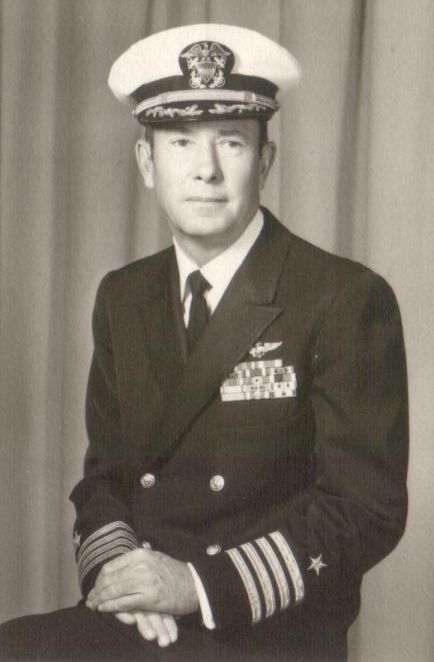
Lloyd and his family lived at 11631 East Colorado drive, Aurora, Colorado.
Captain Montague's last assignment was as Deputy Director of Intelligence for the U.S European Command (J-2) in Stuttgart, Germany. He served under General Alexander Haig of the United States European Command (USEUCOM) at the European Defense Analysis Center (EUDAC), now knwon as the Joint Analysis Center, at Patch Barracks, Stuttgart, Germany. They process, analyze and consolidate signals intelligence to support mission planning and operations by U.S., Allied and NATO commanders. When Lloyd checked in with the commanding General he discovered that this man was soon to depart, and that none other than General H.P. Smith, his old nemesis, was to take over. This period would have been when Anita, a Senior, was attending Stuttgart High School. He served from July 1975 to July 1977.
Lloyd and his family lived at 80 Florida strasse, Vaihingen village, Stuttgart, Germany.
Lloyd retired from the Navy after that tour of duty, completing 30 years of service. He worked for a "beltway bandit," tne Merdan Group, as a Systems Analyst for a while after that as an analyst, but he didn't like the job so he soon retired "full time." He now lives on Chantilly Avenue, in San Diego, California with his wife, Virginia. He is a member of the Association of Former Intelligence Officers (AFIO).
Captain Lloyd Lee Montague died in his sleep at his San Diego home at 8623 Chantilly avenue on 05 March 2020, at the age of 91. He was buried in the East Line cemetery in Bishop, California, next to his wife, Virginia, on 12 March 2020. He will be greatly missed. The Bishop VFW, a wonderful group, provided a color guard, a gun salute, and taps in rememberance. I am deeply grateful. His obituary, written by himself,
"Lloyd Lee Montague August 26, 1928 - March 5, 2020 San Diego Captain Lloyd L. Montague, USN (Retired) a native of Bishop, California attended the Army Navy Academy at Carlsbad, California during the summers of 1944 and 1945. This enabled him to graduate from Bishop High School in three years and join the Navy's Flight Training Program at 17. By the age of 21, he had earned the distinguished Flying Cross and five air medals while serving as an attack pilot during the Korean War. During his 32 year Naval career Captain Montague was awarded over 25 U.S and Foreign Medals and decorations including the U.S Legion of Merit. He served sea duty tours in the Carriers Valley Forge, Princeton, Shangri-La, Bennington, Midway and Oriskany. Aviation shore assignments included the Bureau of Naval Weapons and as an Advanced Flight Instructor in Fleet Attack Aircraft. He was very proud that all 24 of his students received their wings as navy carrier pilots. In 1963, Captain Montague became an intelligence specialist. After Vietnam service he served as Senior Evaluator of Operational Planning and Intelligence during the operational readiness inspections of all Pacific Fleet Carriers deploying to the Vietnam Warfrom 1965 to 1968. Subsequent intelligence assignments were the Nuclear Weapons Training Center, Pacific; Chief of the Weapons Department, Navy Scientific and Technical Intelligence Center and the Defense Intelligence Agency (DIA). At this agency he served in the Intelligence Directorate as Chief of the Operations Branch, Soviet Warsaw Pact Division and later as Chief of the Navy Branch in the Scientific and Technical Directorate.In 1975 he was assigned as Commanding Officer of the Navy Unit at the Lowry AFB School of Applied Aerospace Science where he also served as Deputy Chief of the Armed Forces Air Intelligence Training Center. Captain Montague's last assignment was as Deputy Director of Intelligence for the U.S European Command in Stuttgart, Germany. Since his retirement in 1977 he has resided in the Serra Mesa area of San Diego. Captain Montague was a graduate of the University of Southern California and the Navy Post Graduate School. He was preceded in death by his wife of 55 years Virginia R. Montague in 2006. He is survived by his daughter, Annette Davidson of Yakima, Washington and Anita Hissem of San Diego, and three grandsons. Internment will be at the family plot in Bishop, California on March 11, 2020." - from the San Diego Union of 12 March 2020
Lloyd's children were,
(27) Annette Clare Montague (1951)
(27) Anita Lee Montague (1958)
Annie was born on 19 November 1951. She married first Kenneth Philips. She later married Jon Peter Davidson. Their son is Lee Douglass Davidson. Now divorced, Annie lives in Yakima, Washington.
(27) Anita Lee Montague (1958) Anita Lee Montague, the daughter of Lloyd Lee Montague and Virginia Rose Bassett, was born on 31 January 1958 in Los Angeles, California. This was while her father was finishing his undergraduate degree at the University of Southern California. The next year the family moved to Alameda, California, on San Francisco Bay, where Lloyd was assigneed to the Carrier Division Five staff onboard USS MIDWAY. Early in 1960, after a single deployment, the family moved to Monterey, California where Anita's father studied at the Naval Post Graduate School. The next year, in June 1961, the family moved to Springfield, Virginia while Lloyd was assigned to the Navy Bureau of Weapons at the Pentagon. I believe she attended kingergarten and the 1st grade while there.
Anita Lee Montague, the daughter of Lloyd Lee Montague and Virginia Rose Bassett, was born on 31 January 1958 in Los Angeles, California. This was while her father was finishing his undergraduate degree at the University of Southern California. The next year the family moved to Alameda, California, on San Francisco Bay, where Lloyd was assigneed to the Carrier Division Five staff onboard USS MIDWAY. Early in 1960, after a single deployment, the family moved to Monterey, California where Anita's father studied at the Naval Post Graduate School. The next year, in June 1961, the family moved to Springfield, Virginia while Lloyd was assigned to the Navy Bureau of Weapons at the Pentagon. I believe she attended kingergarten and the 1st grade while there.
Lloyd's next assignment was to the staff of the Commander-in-Chief, Pacific Fleet, in Hawaii. The family road out on the SS LURLINE, a passenger ship of the Matson Line. Anita lived in Hawaii from 1964 to 1968 at Navy Base housing on Iroquois Point, at 5223 Iroquois avenue, Ewa Beach, Oahu. She attended 2nd to 4th grades at Iroquois elementary school. Anita remembers living for a time in the Ilikai hotel on Waikiki beach. She said that during this time the movie "Hawaii" was being filmed and its star, Julie Andrews, was living on the top floor of the hotel. Anita remembers walking with her mother past the hotel's glass elevator, stepping inside, and pushing the button that took it to the top floor. She stepped out at the top and remembers a very nice lady meeting her and getting her back down to her mother. She is sure this was Julie Andrews. However, I don't think Ms. Andrews was staying at the Ilikai, but rather in a rented cottage near Diamond Head. The movie was filmed in 1965.
The family then returned to Alameda, California when Lloyd assigned duty with the staff of Carrier Division Nine onboard USS ORISKANY. They were back in the D.C. area, living in the town of Friendly, now called Fort Washington, in Prince George's county, Maryland from 1970 to 1974. This was while Lloyd was working for the Defense Intelligence Agency (DIA) under General H. P. Smith.
Lloyd's next assignment took the family to Stuttgart, Germany for a tour with the United States European Command (USEUCOM) serving under General Alexander Haig. Anita attended the Stuttgart American High School in Ludwigsburg/Stuttgart, West Germany, graduating in 1976.
In 1977, while her father completed his tour of duty in Germany, Anita started classes at San Diego State Univeristy, eventually earning a Bachelors degree in Biology.
She has, since that time, worked in the Biotech field, including in the ground-breaking company Hybritech.
She began studies for a Masters degree in Systems Management at the University of Southern California where she met Steven Dean Hissem, who she married in February 1987. They have two sons, Jeffrey Lloyd (1989) and Timothy Darrell (1990). They currently reside in the Rancho Bernardo suburb of San Diego, California.
After working many years in the Biotech field Anita retired and became a consultant in FDA/EU compliance issues. In October 2017 she fully retired.
Below is the airport at Bishop where Anita and I flew into in 2008.
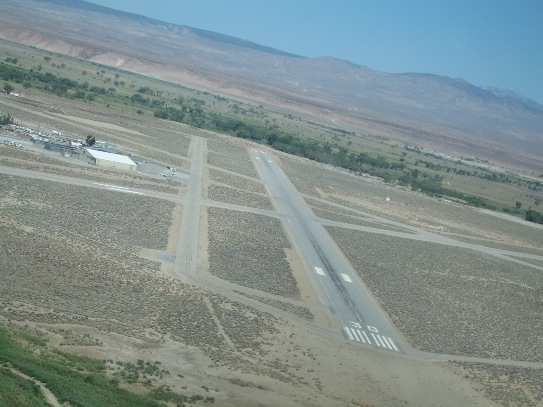
She was born on 11 August 1931 in Bishop, California. She married Sherman Anson Triscuit on 25 November 1953. He had been born on 27 February 1932. She was an elementary school teacher and Sherm was was a Chief Radioman and later, as a civilian, he was a GM14 Supervisory Engineer assigned to the Ridley Mission Control Center as a part of the Air Force Flight Test Center at Edwards Air Force Base, California. After retiring from Federal Service in 1991 he joined SPARTA Corp. Company 2 as deputy Director of Systems Engineering and fully retired in 1997. He holds a Bachelor Degree from Northrop University and a Masters Degree from USC. They live in Lancaster, California. Interestingly, Sherm served on the USS HISSEM. See the page on Ensign Joseph Metcalf Hissem for more details on this ship. Their children were Eric Anson (1961) and Jeannette Claira (1967).